This is “Radical Expressions and Equations”, chapter 8 from the book Beginning Algebra (v. 1.0). For details on it (including licensing), click here.
For more information on the source of this book, or why it is available for free, please see the project's home page. You can browse or download additional books there. To download a .zip file containing this book to use offline, simply click here.
Chapter 8 Radical Expressions and Equations
8.1 Radicals
Learning Objectives
- Find square roots.
- Find cube roots.
- Find nth roots.
- Simplify expressions using the product and quotient rules for radicals.
Square Roots
The square rootThe number that, when multiplied by itself, yields the original number. of a number is that number that when multiplied by itself yields the original number. For example, 4 is a square root of 16, because . Since , we can say that −4 is a square root of 16 as well. Every positive real number has two square roots, one positive and one negative. For this reason, we use the radical sign to denote the principal (nonnegative) square rootThe positive square root of a real number, denoted with the symbol . and a negative sign in front of the radical to denote the negative square root.

Zero is the only real number with one square root.

If the radicandThe expression a within a radical sign, ., the number inside the radical sign, is nonnegative and can be factored as the square of another nonnegative number, then the square root of the number is apparent. In this case, we have the following property:

Example 1: Find the square root.
a.
b.
c.
d.
Solution:
a.
b.
c.
d.
Example 2: Find the negative square root.
a.
b.
Solution:
a.
b.
The radicand may not always be a perfect square. If a positive integer is not a perfect square, then its square root will be irrational. For example, is an irrational number and can be approximated on most calculators using the square root button.

Next, consider the square root of a negative number. To determine the square root of −9, you must find a number that when squared results in −9:

However, any real number squared always results in a positive number:

The square root of a negative number is currently left undefined. For now, we will state that is not a real a number.
Cube Roots
The cube rootThe number that, when used as a factor with itself three times, yields the original number; it is denoted with the symbol . of a number is that number that when multiplied by itself three times yields the original number. Furthermore, we denote a cube root using the symbol , where 3 is called the indexThe positive integer n in the notation that is used to indicate an nth root.. For example,

The product of three equal factors will be positive if the factor is positive and negative if the factor is negative. For this reason, any real number will have only one real cube root. Hence the technicalities associated with the principal root do not apply. For example,

In general, given any real number a, we have the following property:

When simplifying cube roots, look for factors that are perfect cubes.
Example 3: Find the cube root.
a.
b.
c.
d.
Solution:
a.
b.
c.
d.
Example 4: Find the cube root.
a.
b.
c.
Solution:
a.
b.
c.
It may be the case that the radicand is not a perfect cube. If an integer is not a perfect cube, then its cube root will be irrational. For example, is an irrational number which can be approximated on most calculators using the root button. Depending on the calculator, we typically type in the index prior to pushing the button and then the radicand as follows:

Therefore, we have

nth Roots
For any integer , we define the nth rootThe number that, when raised to the nth power, yields the original number. of a positive real number as that number that when raised to the nth power yields the original number. Given any nonnegative real number a, we have the following property:

Here is called the index and is called the radicand. Furthermore, we can refer to the entire expression as a radicalUsed when referring to an expression of the form .. When the index is an integer greater than 3, we say “fourth root”, “fifth root”, and so on. The nth root of any number is apparent if we can write the radicand with an exponent equal to the index.
Example 5: Find the nth root.
a.
b.
c.
d.
Solution:
a.
b.
c.
d.
If the index is , then the radical indicates a square root and it is customary to write the radical without the index, as illustrated below:

We have already taken care to define the principal square root of a number. At this point, we extend this idea to nth roots when n is even. For example, 3 is a fourth root of 81, because . And since , we can say that −3 is a fourth root of 81 as well. Hence we use the radical sign to denote the principal (nonnegative) nth rootThe positive nth root when n is even. when n is even. In this case, for any real number a, we use the following property:

For example,

The negative nth root, when n is even, will be denoted using a negative sign in front of the radical .

We have seen that the square root of a negative number is not real because any real number, when squared, will result in a positive number. In fact, a similar problem arises for any even index:

Here the fourth root of −81 is not a real number because the fourth power of any real number is always positive.

Example 6: Simplify.
a.
b.
Solution:
a. The radicand is negative and the index is even. Therefore, there is no real number that when raised to the fourth power is −16.

b. Here the radicand is positive. Furthermore, , and we can simplify as follows:

When n is odd, the same problems do not occur. The product of an odd number of positive factors is positive and the product of an odd number of negative factors is negative. Hence when the index n is odd, there is only one real nth root for any real number a. And we have the following property:

Example 7: Find the nth root.
a.
b.
Solution:
a.
b.
Try this! Find the fourth root: .
Answer: 5
Video Solution
(click to see video)Summary: When n is odd, the nth root is positive or negative depending on the sign of the radicand.

When n is even, the nth root is positive or not real depending on the sign of the radicand.

Simplifying Using the Product and Quotient Rule for Radicals
It will not always be the case that the radicand is a perfect power of the given index. If not, we use the following two properties to simplify them. If a and b represent positive real numbers, then we have
Product rule for radicals, where a and b represent positive real numbers.: |
|
Quotient rule for radicals, where a and b represent positive real numbers.: |
A radical is simplifiedA radical where the radicand does not consist of any factor that can be written as a perfect power of the index. if it does not contain any factor that can be written as a perfect power of the index.
Example 8: Simplify: .
Solution: Here 12 can be written as 4 ⋅ 3, where 4 is a perfect square.

We can verify our answer on a calculator:

Also, it is worth noting that

Answer:
Example 9: Simplify: .
Solution: Begin by finding the largest perfect square factor of 135.

Therefore,

Answer:
Example 10: Simplify: .
Solution: Begin by finding the prime factorizations of both 50 and 121. This will enable us to easily determine the largest perfect square factors.

Therefore,
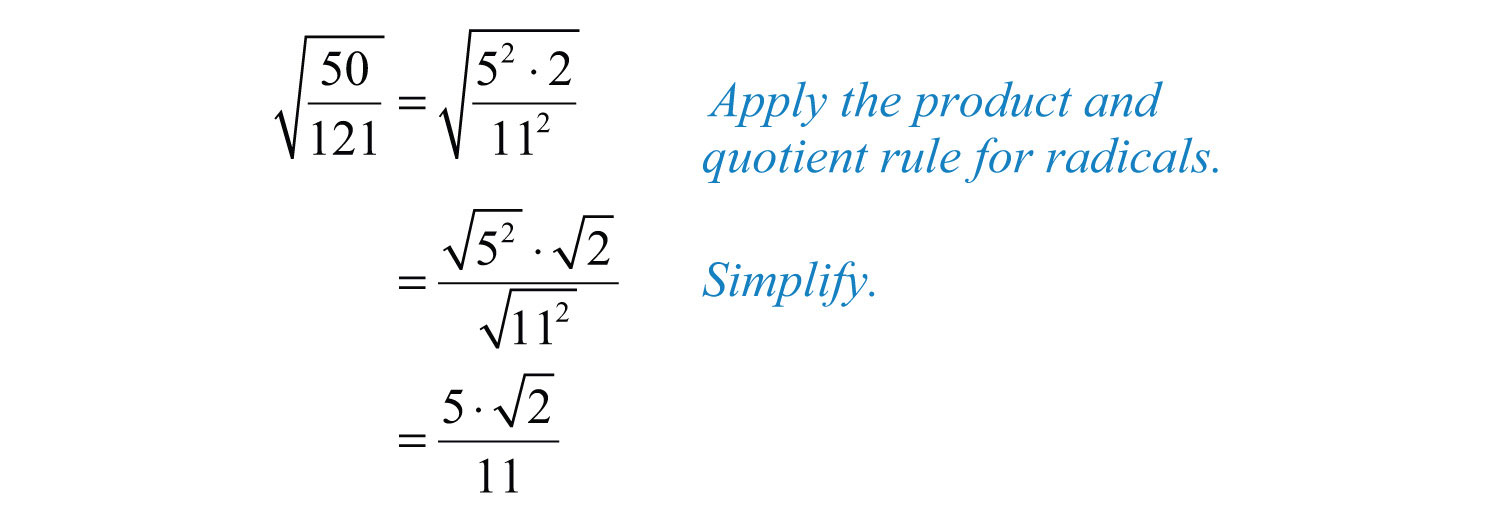
Answer:
Example 11: Simplify: .
Solution: Use the prime factorization of 162 to find the largest perfect cube factor:

Replace the radicand with this factorization and then apply the product rule for radicals.

We can verify our answer on a calculator.

Answer:
Try this! Simplify: .
Answer:
Video Solution
(click to see video)
Example 12: Simplify: .
Solution: Here we note that the index is odd and the radicand is negative; hence the result will be negative. We can factor the radicand as follows:

Then simplify:

Answer:
Example 13: Simplify: .
Solution: In this case, consider the equivalent fraction with in the numerator and then simplify.
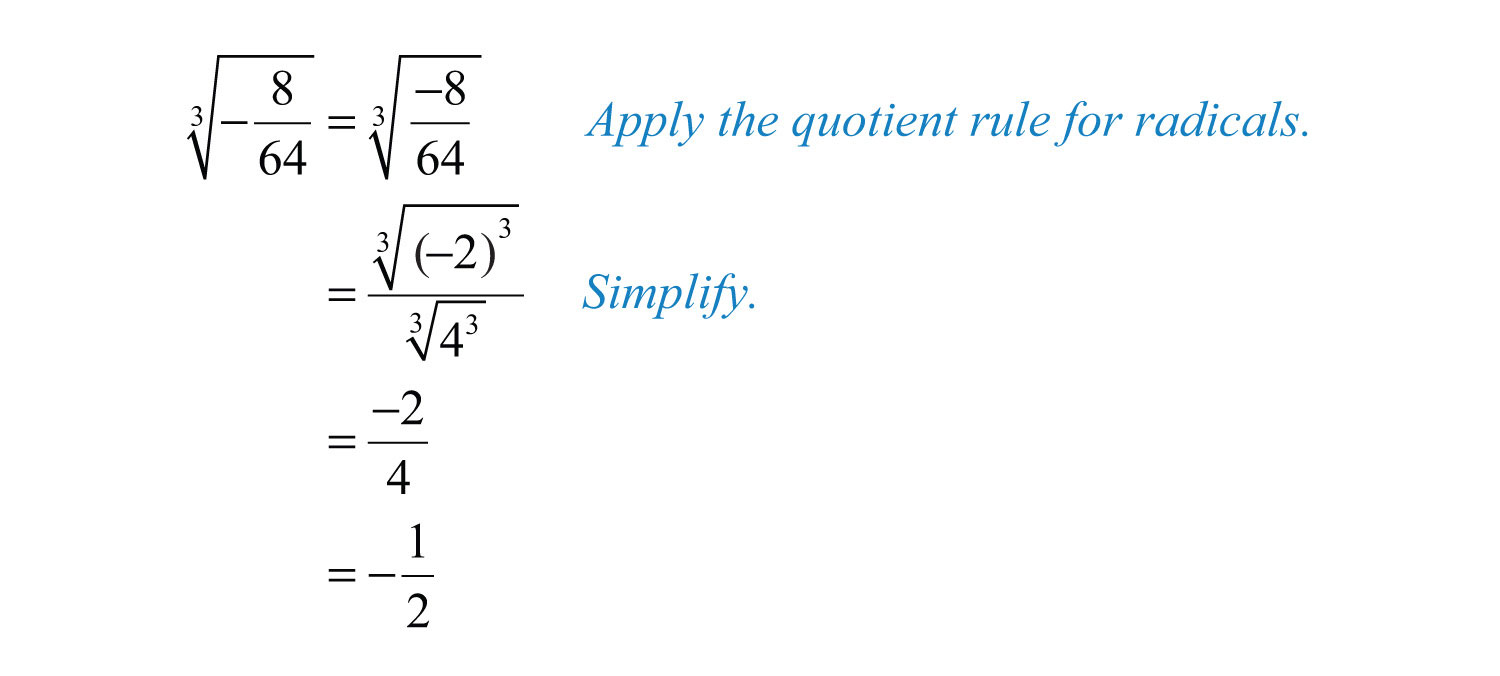
Answer: −1/2
Try this! Simplify .
Answer:
Video Solution
(click to see video)Key Takeaways
- The square root of a number is that number that when multiplied by itself yields the original number. When the radicand a is positive, . When the radicand is negative, the result is not a real number.
- The cube root of a number is that number that when used as a factor with itself three times yields the original number. The cube root may be positive or negative depending on the sign of the radicand. Therefore, for any real number a, we have the property .
- When working with nth roots, n determines the definition that applies. We use when n is odd and when n is even. When n is even, the negative nth root is denoted with a negative sign in front of the radical sign.
- To simplify square roots, look for the largest perfect square factor of the radicand and then apply the product or quotient rule for radicals.
- To simplify cube roots, look for the largest perfect cube factor of the radicand and then apply the product or quotient rule for radicals.
- To simplify nth roots, look for the factors that have a power that is equal to the index n and then apply the product or quotient rule for radicals. Typically, the process is streamlined if you work with the prime factorization of the radicand.
Topic Exercises
Part A: Radicals
Simplify.
1.
2.
3.
4.
5.
6.
7.
8.
9.
10.
11.
12.
13.
14.
15.
16.
17.
18.
19.
20.
21.
22.
23.
24.
25.
26.
27.
28.
29.
30.
31.
32.
33.
34.
35.
36.
37.
38.
39.
40.
41.
42.
43.
44.
45.
46.
47.
48.
49.
50.
51.
52.
53.
54.
55.
56.
57.
58.
59.
60.
61.
62.
63.
64.
65.
66.
Part B: Simplifying Radicals
Simplify.
67.
68.
69.
70.
71.
72.
73.
74.
75.
76.
77.
78.
79.
80.
81.
82.
83.
84.
85.
86.
87.
88.
89.
90.
91.
92.
93.
94.
95.
96.
97.
98.
99.
100.
Simplify. Give the exact answer and the approximate answer rounded to the nearest hundredth.
101.
102.
103.
104.
105.
106.
107.
108.
109.
110.
111.
112.
Rewrite the following as a radical expression with coefficient 1.
113.
114.
115.
116.
117.
118.
119.
120.
121. The formula for the area A of a square is . If the area is 18 square units, then what is the length of each side?
122. Calculate the length of a side of a square with an area of 60 square centimeters.
123. The formula for the volume V of a cube is . If the volume of a cube is 112 cubic units, then what is the length of each side?
124. Calculate the length of a side of a cube with a volume of 54 cubic centimeters.
Part C: Discussion Board
125. Explain why there are two square roots for any nonzero real number.
126. Explain why there is only one cube root for any real number.
127. What is the square root of 1, and what is the cube root of 1? Explain why.
128. Explain why is not a real number and why is a real number.
Answers
1: 9
3: 8
5: 0
7: 0.5
9: 1.1
11: 1/2
13: 5/4
15: Not a real number
17: −6
19: −10
21: 3
23: 4
25: 1/2
27: 2/3
29: 0.1
31: −1
33: −3
35: −1/2
37: −2/3
39: 3
41: 2
43: 2
45: 3
47: −2
49: −2
51: Not a real number
53: 15
55: −50
57: Not a real number
59: 15
61: 6
63: −14
65: 60
67:
69:
71:
73:
75:
77:
79:
81:
83:
85:
87:
89:
91:
93:
95:
97:
99:
101:
103:
105:
107:
109:
111:
113:
115:
117:
119:
121: units
123: units
8.2 Simplifying Radical Expressions
Learning Objectives
- Simplify radical expressions using the product and quotient rule for radicals.
- Use formulas involving radicals.
- Evaluate given square root and cube root functions.
Simplifying Radical Expressions
An algebraic expression that contains radicals is called a radical expressionAn algebraic expression that contains radicals.. We use the product and quotient rules to simplify them.
Example 1: Simplify: .
Solution: Use the fact that when n is odd.

Answer:
Example 2: Simplify: .
Solution: The square root has index 2; use the fact that when n is even.

Since x is a variable, it may represent a negative number. Thus we need to ensure that the result is positive by including the absolute value operator.
Answer:
Important Note
Typically, at this point beginning algebra texts note that all variables are assumed to be positive. If this is the case, then x in the previous example is positive and the absolute value operator is not needed. The example can be simplified as follows:
In this section, we will assume that all variables are positive. This allows us to focus on calculating nth roots without the technicalities associated with the principal nth root problem. For this reason, we will use the following property for the rest of the section:
When simplifying radical expressions, look for factors with powers that match the index.
Example 3: Simplify: .
Solution: Begin by determining the square factors of 18, , and .

Make these substitutions and then apply the product rule for radicals and simplify.

Answer:
Example 4: Simplify: .
Solution: Begin by determining the square factors of 4, , and .

Make these substitutions and then apply the product rule for radicals and simplify.
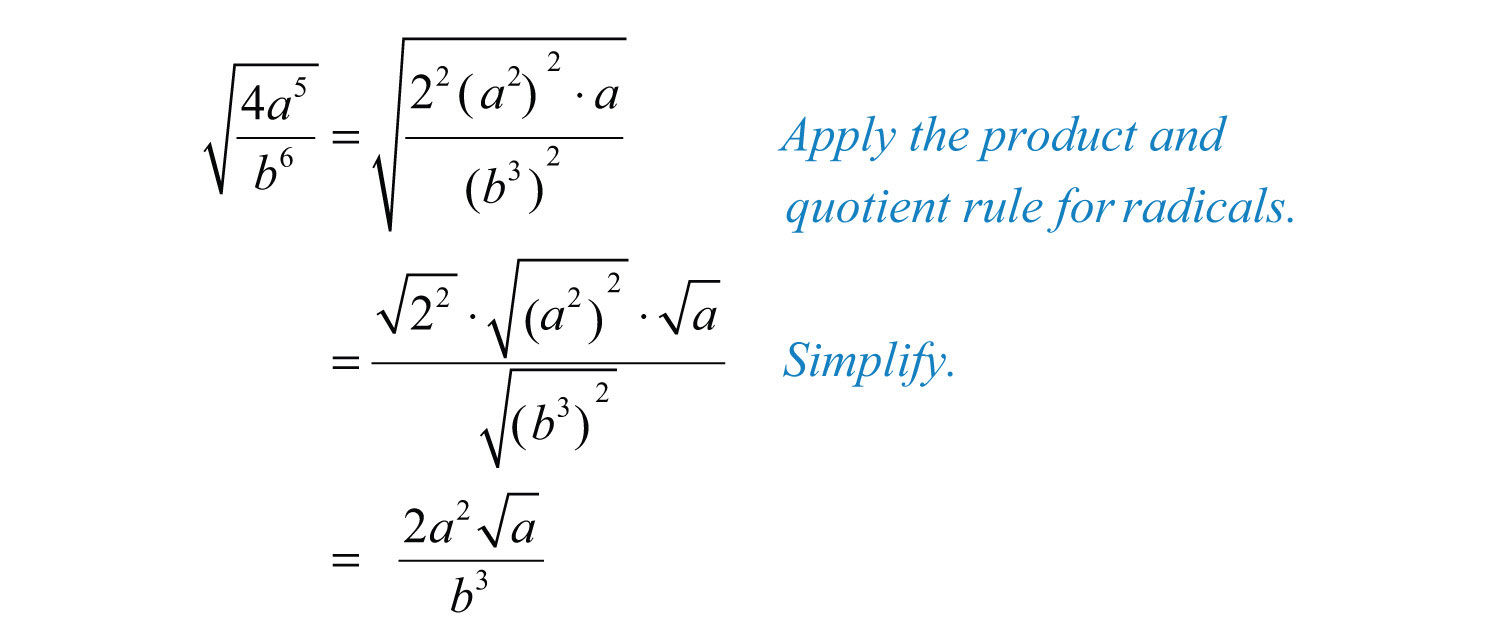
Answer:
Example 5: Simplify: .
Solution: Begin by determining the cubic factors of 80, , and .

Make these substitutions and then apply the product rule for radicals and simplify.

Answer:
Example 6: Simplify .
Solution: The coefficient and thus does not have any perfect cube factors. It will be left as the only remaining radicand because all of the other factors are cubes, as illustrated below:

Replace the variables with these equivalents, apply the product and quotient rule for radicals, and then simplify.
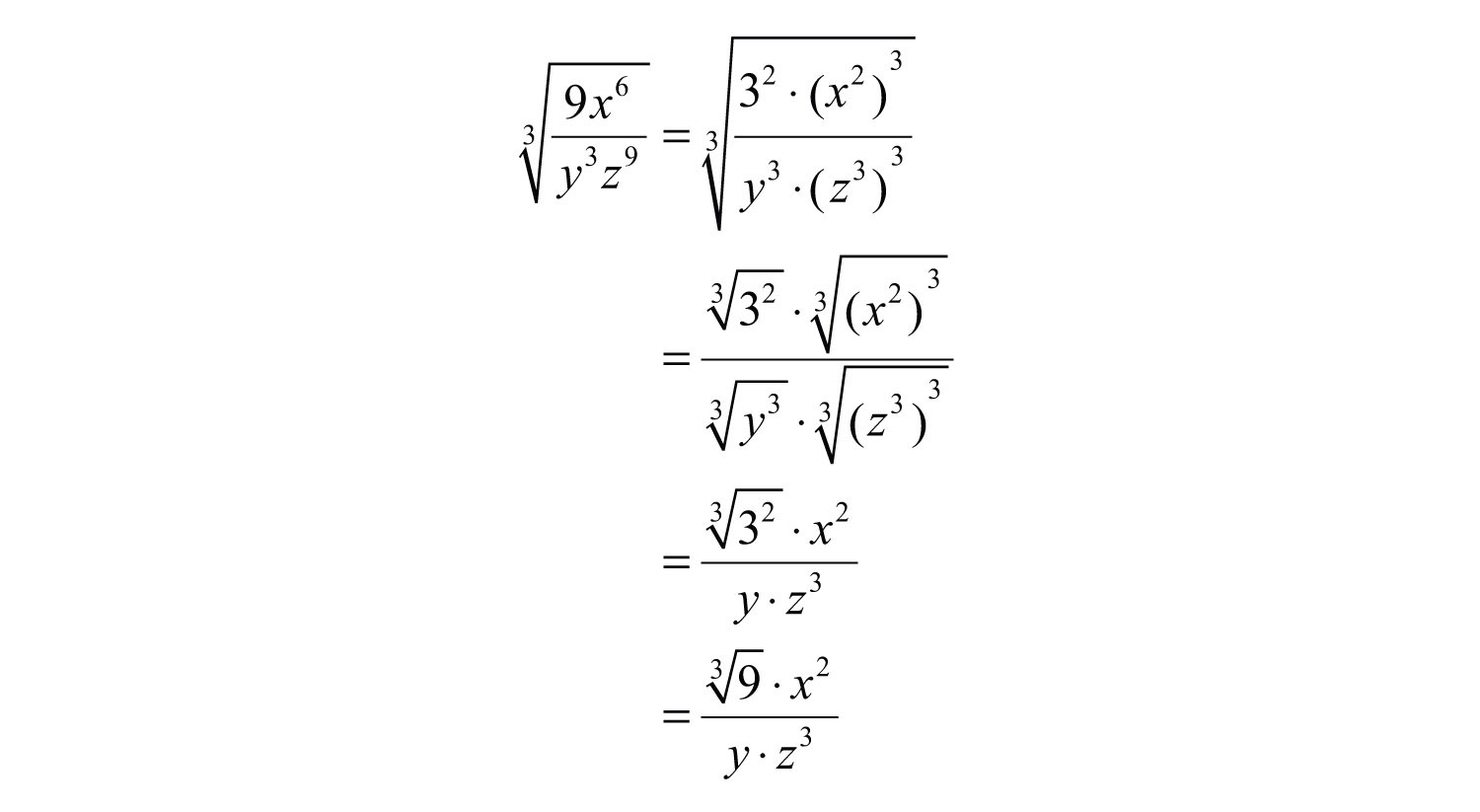
Answer:
Example 7: Simplify: .
Solution: Determine all factors that can be written as perfect powers of 4. Here it is important to see that . Hence the factor will be left inside the radical.

Answer:
Example 8: Simplify: .
Solution: Notice that the variable factor x cannot be written as a power of 5 and thus will be left inside the radical. In addition, for ; the factor y will be left inside the radical as well.

Answer:
Try this! Simplify: . (Assume all variables are positive.)
Answer:
Video Solution
(click to see video)Tip
To easily simplify an nth root, we can divide the powers by the index.
If the index does not divide into the power evenly, then we can use the quotient and remainder to simplify. For example,
The quotient is the exponent of the factor outside of the radical, and the remainder is the exponent of the factor left inside the radical.
Formulas Involving Radicals
We next review the distance formula. Given two points and ,

The distance, d, between them is given by the following formula:
Distance formulaGiven two points and calculate the distance d between them using the formula d = : |
Recall that this formula was derived from the Pythagorean theorem.
Example 9: Calculate the distance between (−4, 7) and (2, 1).
Solution: Use the distance formula with the following points.

It is a good practice to include the formula in its general form before substituting values for the variables; this improves readability and reduces the probability of making errors.
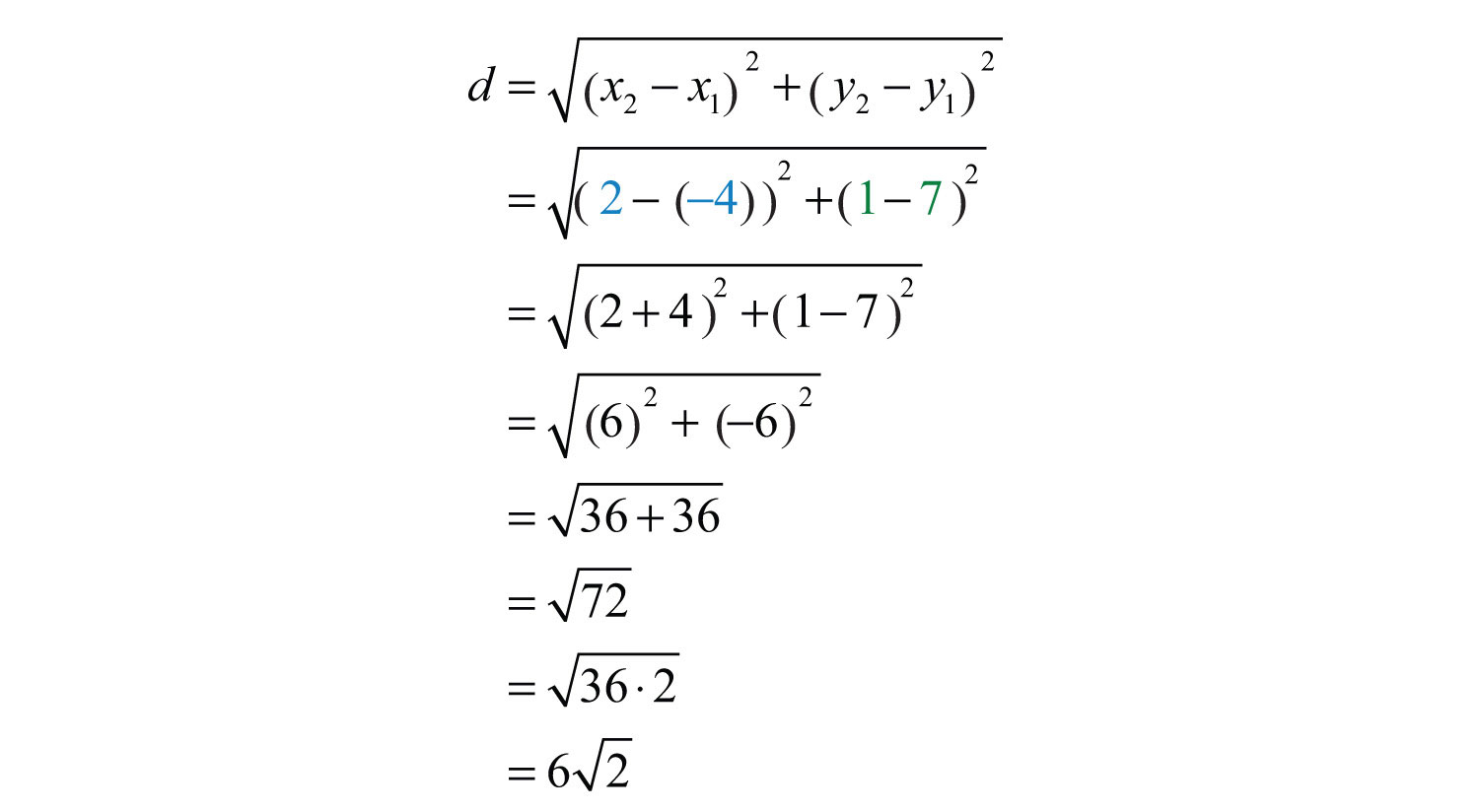
Answer: units
Example 10: The period, T, of a pendulum in seconds is given by the formula

where L represents the length of the pendulum in feet. If the length of a pendulum measures 6 feet, then calculate the period rounded off to the nearest tenth of a second.

Solution: Substitute 6 for L and then simplify.
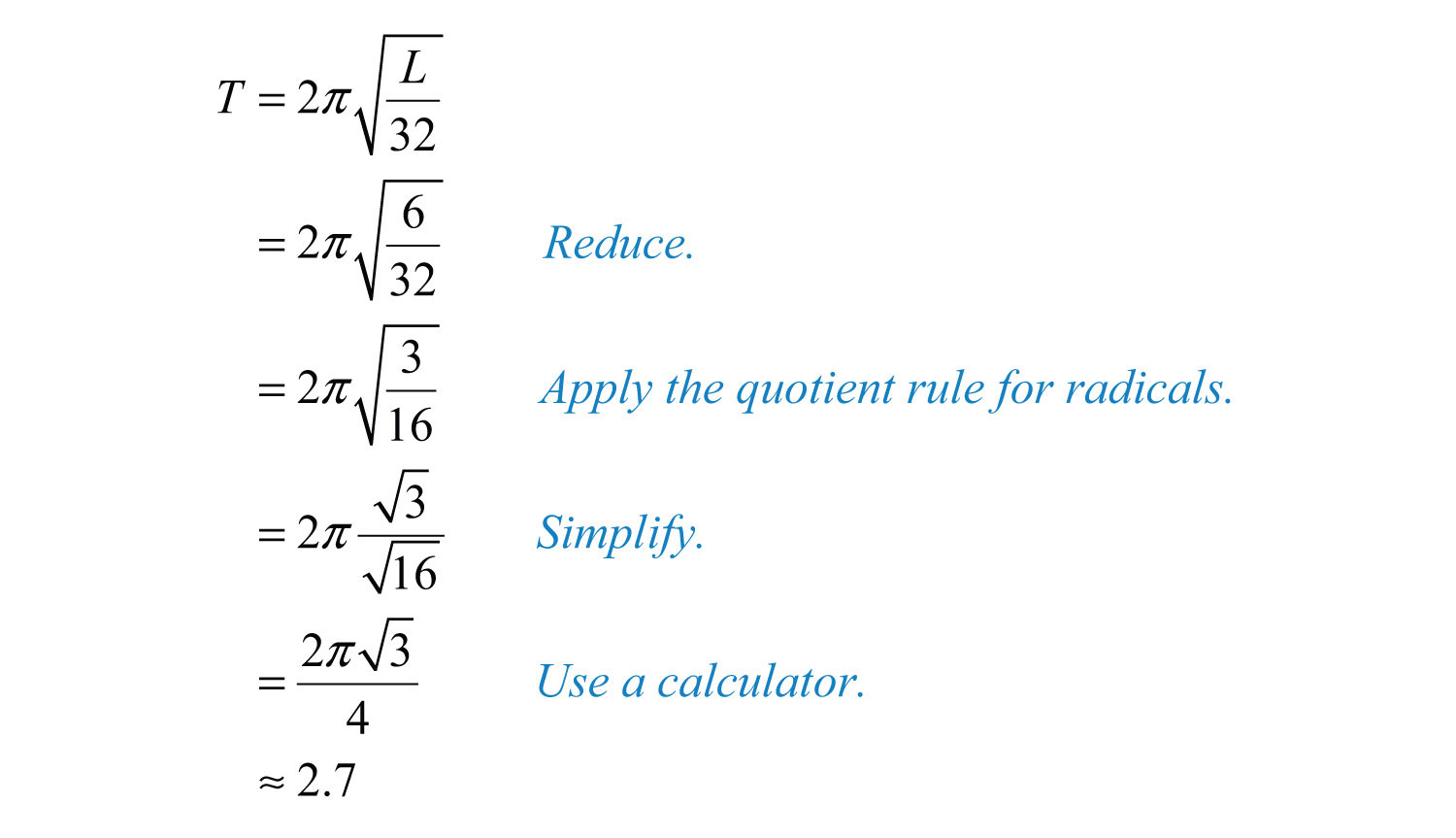
Answer: The period is approximately 2.7 seconds.
Square Root and Cube Root Functions
We begin with the square root functionThe function .:

We know that the square root is not a real number when the radicand x is negative. Therefore, we conclude that the domain consists of all real numbers greater than or equal to 0. Here we choose 0 and some positive values for x, calculate the corresponding y-values, and plot the resulting ordered pairs.

After plotting the points, we can then sketch the graph of the square root function.
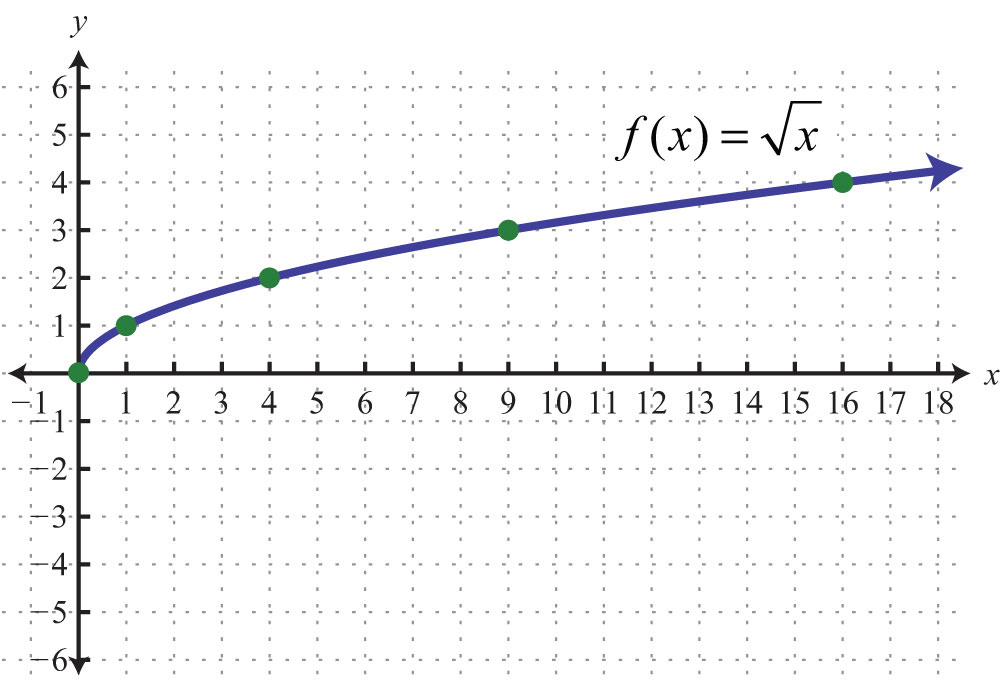
Example 11: Given the function , find , , and .
Solution: Replace x with each of the given values.

Answer: , , and
Next, consider the cube root functionThe function .:

Since the cube root could be either negative or positive, we conclude that the domain consists of all real numbers. For completeness, choose some positive and negative values for x, as well as 0, and then calculate the corresponding y-values.

Plot the points and sketch the graph of the cube root function.

Example 12: Given the function , find , , and .
Solution: Replace x with each of the given values.
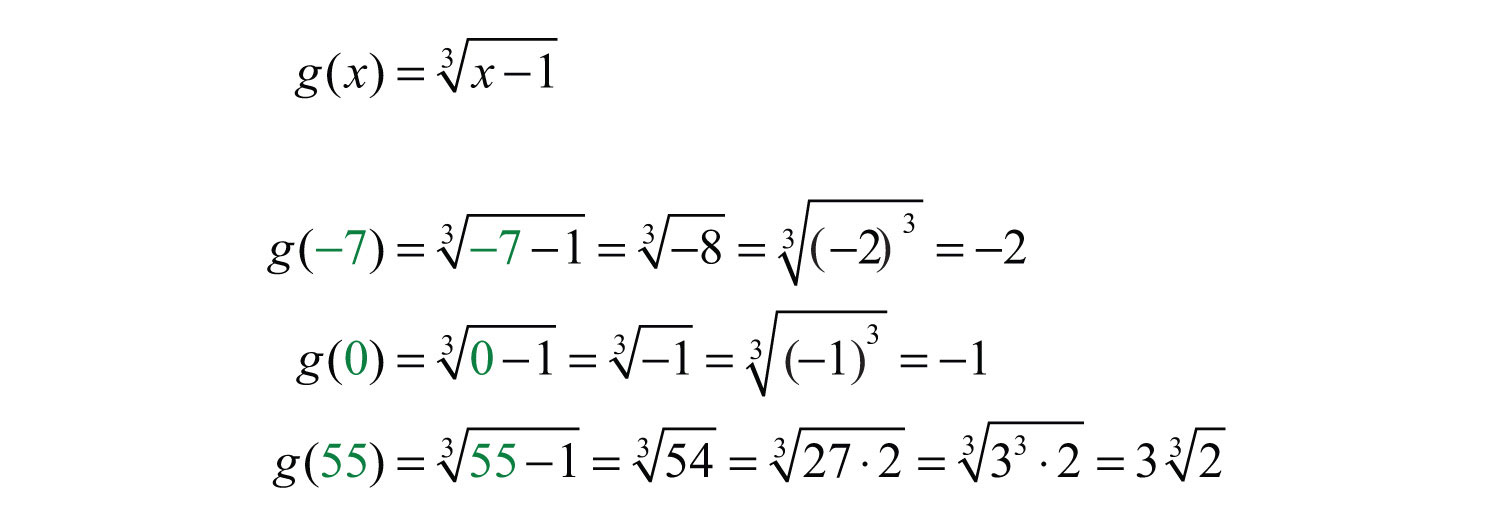
Answer: , , and
Key Takeaways
- In beginning algebra, we typically assume that all variable expressions within the radical are positive. This allows us to focus on simplifying radicals without the technical issues associated with the principal nth root.
- To simplify radical expressions, look for factors of the radicand with powers that match the index. If found, they can be simplified by applying the product and quotient rules for radicals, as well as the property , where a is positive.
Topic Exercises
Part A: Simplifying Radical Expressions
Simplify. (Assume all variables represent positive numbers.)
1.
2.
3.
4.
5.
6.
7.
8.
9.
10.
11.
12.
13.
14.
15.
16.
17.
18.
19.
20.
21.
22.
23.
24.
25.
26.
27.
28.
29.
30.
31.
32.
33.
34.
35.
36.
37.
38.
39.
40.
41.
42.
43.
44.
45.
46.
47.
48.
49.
50.
51.
52.
53.
54.
55.
56.
Rewrite the following as a radical expression with coefficient 1.
57.
58.
59.
60.
61.
62.
63.
64.
65.
66.
67.
68.
Assume that the variable could represent any real number and then simplify.
69.
70.
71.
72.
73.
74.
75.
76.
77.
78.
79.
80.
81.
82.
Part B: Formulas Involving Radicals
The y-intercepts for any graph will have the form (0, y), where y is a real number. Therefore, to find y-intercepts, set x = 0 and solve for y. Find the y-intercepts for the following.
83.
84.
85.
86.
Use the distance formula to calculate the distance between the given two points.
87. (5, −7) and (3, −8)
88. (−9, 7) and (−8, 4)
89. (−3, −4) and (3, −6)
90. (−5, −2) and (1, −6)
91. (−1, 1) and (−4, 10)
92. (8, −3) and (2, −12)
Factor the radicand and then simplify. (Assume that all expressions are positive.)
93.
94.
95.
96.
97. The speed of a vehicle before the brakes were applied can be estimated by the length of the skid marks left on the road. On dry pavement, the speed, v, in miles per hour can be estimated by the formula , where d represents the length of the skid marks in feet. Estimate the speed of a vehicle before applying the brakes on dry pavement if the skid marks left behind measure 36 feet.
98. The radius, r, of a sphere can be calculated using the formula , where V represents the sphere’s volume. What is the radius of a sphere if the volume is cubic centimeters?
The period, T, of a pendulum in seconds is given by the formula
where L represents the length in feet. Calculate the period, given the following lengths. Give the exact value and the approximate value rounded off to the nearest tenth of a second.
99. 8 feet
100. 32 feet
101. 1/2 foot
102. 1/8 foot
The time, t, in seconds that an object is in free fall is given by the formula
where s represents the distance it has fallen in feet. Calculate the time it takes an object to fall, given the following distances. Give the exact value and the approximate value rounded off to the nearest tenth of a second.
103. 48 feet
104. 80 feet
105. 192 feet
106. 288 feet
Part C: Radical Functions
Given the function, calculate the following.
107. , find , , and
108. , find , , and
109. , find , , and
110. , find , , and
111. , find , , and
112. , find , , and
113. , find , , and
114. , find , , and
For each function, fill in the table.
115.
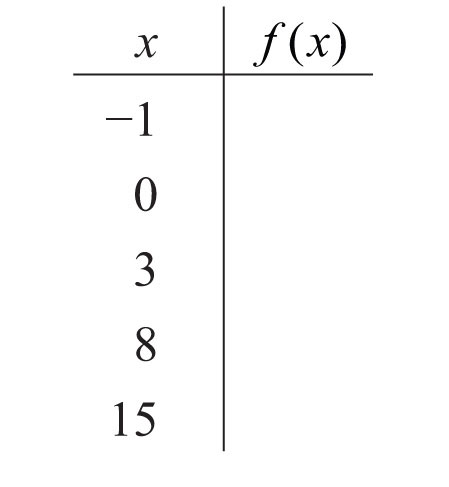
116.

117.
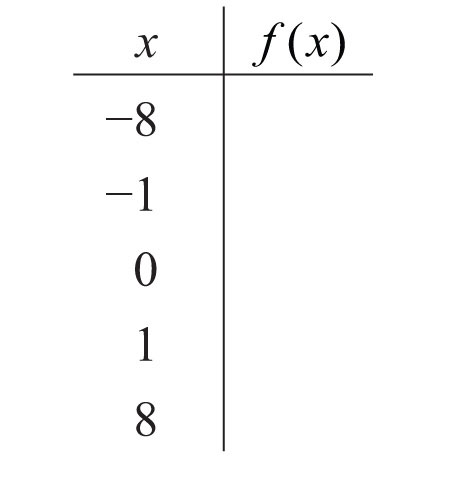
118.

Part D: Discussion Board
119. Give a value for x such that . Explain why it is important to assume that the variables represent positive numbers.
120. Research and discuss the accomplishments of Christoph Rudolff. What is he credited for?
121. Research and discuss the methods used for calculating square roots before the common use of electronic calculators.
122. What is a surd, and where does the word come from?
Answers
1:
3:
5:
7:
9:
11:
13:
15:
17:
19:
21:
23:
25:
27:
29:
31:
33:
35:
37:
39:
41:
43:
45:
47:
49:
51:
53:
55:
57:
59:
61:
63:
65:
67:
69:
71:
73:
75:
77:
79:
81:
83: (0, 1)
85: (0, 1)
87:
89:
91:
93:
95:
97: 30 miles per hour
99: seconds
101: seconds
103: seconds
105: seconds
107: , , and
109: , , and
111: , , and
113: , , and
115:
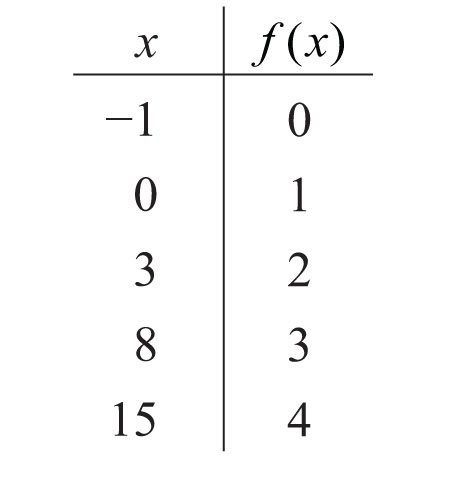
117:
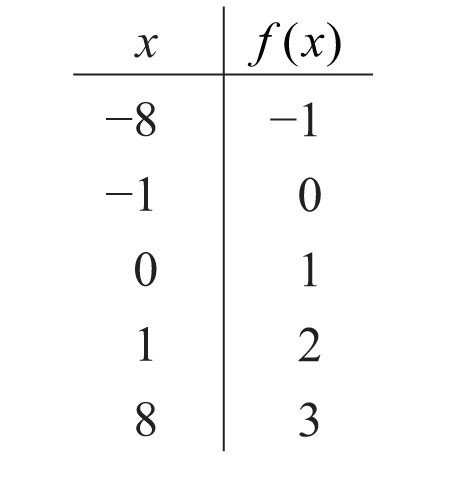
8.3 Adding and Subtracting Radical Expressions
Learning Objectives
- Add and subtract like radicals.
- Simplify radical expressions involving like radicals.
Adding and Subtracting Radical Expressions
Adding and subtracting radical expressions is similar to adding and subtracting like terms. Radicals are considered to be like radicalsRadicals that share the same index and radicand., or similar radicalsTerm used when referring to like radicals., when they share the same index and radicand. For example, the terms and contain like radicals and can be added using the distributive property as follows:

Typically, we do not show the step involving the distributive property and simply write

When adding terms with like radicals, add only the coefficients; the radical part remains the same.
Example 1: Add: .
Solution: The terms contain like radicals; therefore, add the coefficients.

Answer:
Subtraction is performed in a similar manner.
Example 2: Subtract: .
Solution:

Answer:
If the radicand and the index are not exactly the same, then the radicals are not similar and we cannot combine them.
Example 3: Simplify: .
Solution:

We cannot simplify any further because and are not like radicals; the radicands are not the same.
Answer:
Caution
It is important to point out that . We can verify this by calculating the value of each side with a calculator.

In general, note that .
Example 4: Simplify: .
Solution:

We cannot simplify any further because and are not like radicals; the indices are not the same.
Answer:
Often we will have to simplify before we can identify the like radicals within the terms.
Example 5: Subtract: .
Solution: At first glance, the radicals do not appear to be similar. However, after simplifying completely, we will see that we can combine them.

Answer:
Example 6: Simplify: .
Solution:

Answer:
Try this! Subtract: .
Answer:
Video Solution
(click to see video)Next, we work with radical expressions involving variables. In this section, assume all radicands containing variable expressions are not negative.
Example 7: Simplify: .
Solution:

We cannot combine any further because the remaining radical expressions do not share the same radicand; they are not like radicals. Note that .
Answer:
We will often find the need to subtract a radical expression with multiple terms. If this is the case, remember to apply the distributive property before combining like terms.
Example 8: Simplify: .
Solution:

Answer:
Until we simplify, it is often unclear which terms involving radicals are similar.
Example 9: Simplify: .
Solution:

Answer:
Example 10: Simplify: .
Solution:

Answer:
Try this! Simplify: .
Answer:
Video Solution
(click to see video)Tip
Take careful note of the differences between products and sums within a radical.
| Products | Sums |
|---|---|
The property says that we can simplify radicals when the operation in the radicand is multiplication. There is no corresponding property for addition.
Key Takeaways
- Add and subtract terms that contain like radicals just as you do like terms. If the index and radicand are exactly the same, then the radicals are similar and can be combined. This involves adding or subtracting only the coefficients; the radical part remains the same.
- Simplify each radical completely before combining like terms.
Topic Exercises
Part A: Adding and Subtracting Like Radicals
Simplify.
1.
2.
3.
4.
5.
6.
7.
8.
9.
10.
11.
12.
13.
14.
15.
16.
Simplify. (Assume all radicands containing variable expressions are positive.)
17.
18.
19.
20.
21.
22.
23.
24.
25.
26.
27.
28.
29.
30.
31.
32.
33.
34.
Part B: Adding and Subtracting Rational Expressions
Simplify.
35.
36.
37.
38.
39.
40.
41.
42.
43.
44.
45.
46.
47.
48.
49.
50.
51.
52.
53.
54.
55.
56.
57.
58.
Simplify. (Assume all radicands containing variable expressions are positive.)
59.
60.
61.
62.
63.
64.
65.
66.
67.
68.
69.
70.
71.
72.
73.
74.
75.
76.
77.
78.
79.
80.
81.
82.
83.
84.
85.
86.
87.
88.
89.
90.
Part C: Discussion Board
91. Choose values for x and y and use a calculator to show that .
92. Choose values for x and y and use a calculator to show that .
Answers
1:
3:
5:
7:
9:
11:
13:
15:
17:
19:
21:
23:
25:
27:
29:
31:
33:
35:
37:
39:
41:
43:
45:
47:
49:
51:
53:
55:
57:
59:
61:
63:
65:
67:
69:
71:
73:
75:
77:
79:
81:
83:
85:
87:
89:
8.4 Multiplying and Dividing Radical Expressions
Learning Objectives
- Multiply radical expressions.
- Divide radical expressions.
- Rationalize the denominator.
Multiplying Radical Expressions
When multiplying radical expressions with the same index, we use the product rule for radicals. If a and b represent positive real numbers,

Example 1: Multiply: .
Solution: This problem is a product of two square roots. Apply the product rule for radicals and then simplify.

Answer:
Example 2: Multiply: .
Solution: This problem is a product of cube roots. Apply the product rule for radicals and then simplify.

Answer:
Often there will be coefficients in front of the radicals.
Example 3: Multiply: .
Solution: Using the product rule for radicals and the fact that multiplication is commutative, we can multiply the coefficients and the radicands as follows.

Typically, the first step involving the application of the commutative property is not shown.
Answer:
Example 4: Multiply: .
Solution:

Answer:
Use the distributive property when multiplying rational expressions with more than one term.
Example 5: Multiply: .
Solution: Apply the distributive property and multiply each term by .

Answer:
Example 6: Multiply: .
Solution: Apply the distributive property and then simplify the result.
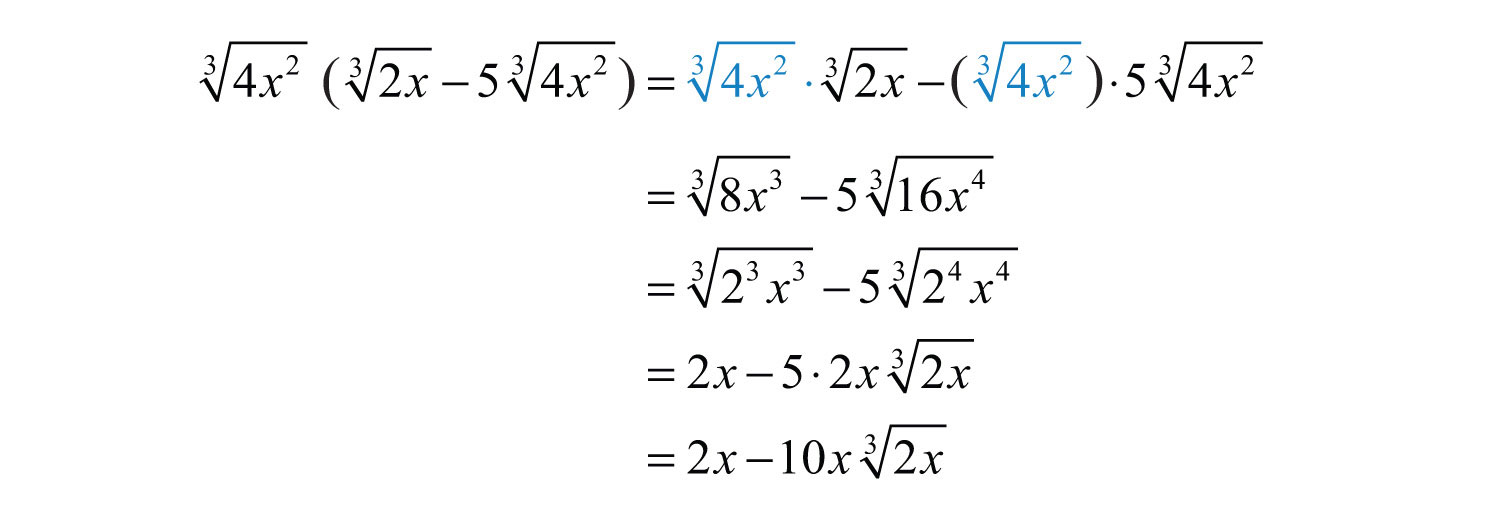
Answer:
The process for multiplying radical expressions with multiple terms is the same process used when multiplying polynomials. Apply the distributive property, simplify each radical, and then combine like terms.
Example 7: Multiply: .
Solution: Begin by applying the distributive property.
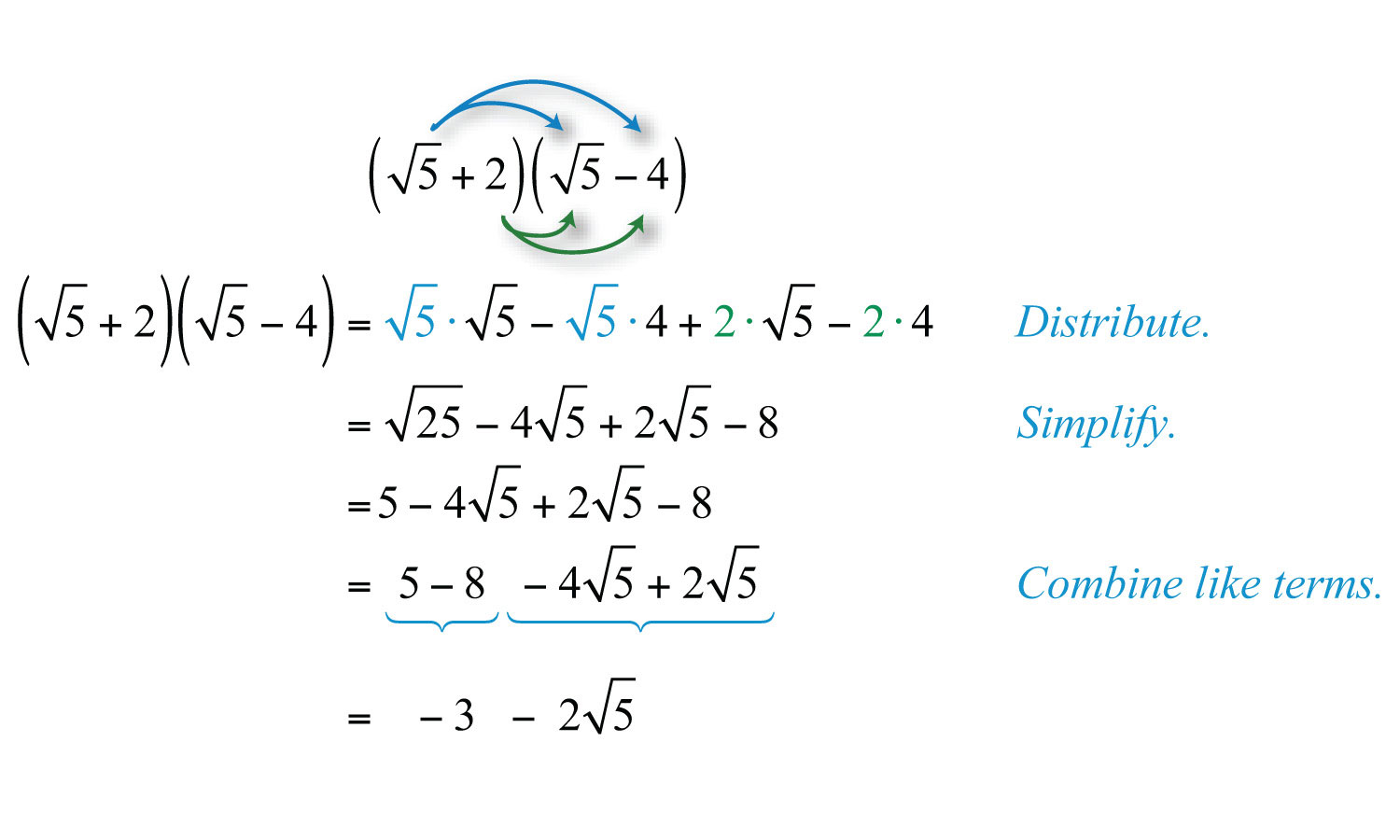
Answer:
Example 8: Multiply: .
Solution:

Answer:
Try this! Multiply: .
Answer:
Video Solution
(click to see video)The expressions and are called conjugatesThe factors and are conjugates.. When multiplying conjugates, the sum of the products of the inner and outer terms results in 0.
Example 9: Multiply: .
Solution: Apply the distributive property and then combine like terms.

Answer: −3
It is important to note that when multiplying conjugate radical expressions, we obtain a rational expression. This is true in general and is often used in our study of algebra.

Therefore, for nonnegative real numbers a and b, we have the following property:

Dividing Radical Expressions (Rationalizing the Denominator)
To divide radical expressions with the same index, we use the quotient rule for radicals. If a and b represent nonnegative numbers, where , then we have

Example 10: Divide: .
Solution: In this case, we can see that 10 and 80 have common factors. If we apply the quotient rule for radicals and write it as a single square root, we will be able to reduce the fractional radicand.

Answer:
Example 11: Divide: .
Solution:
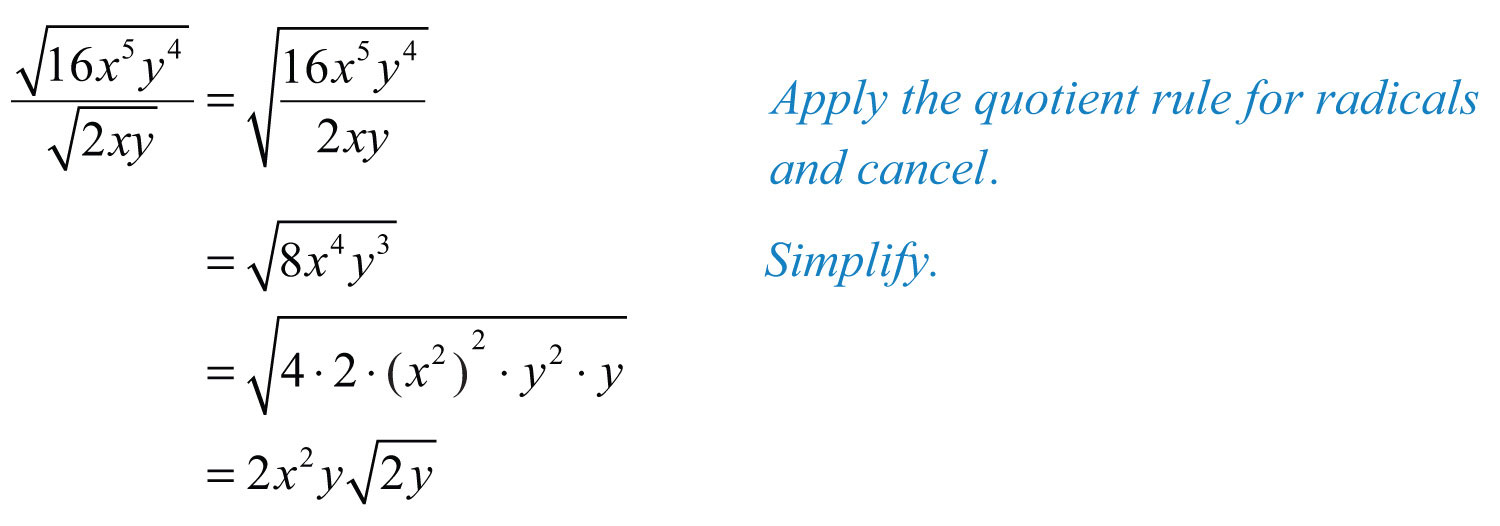
Answer:
Example 12: Divide: .
Solution:
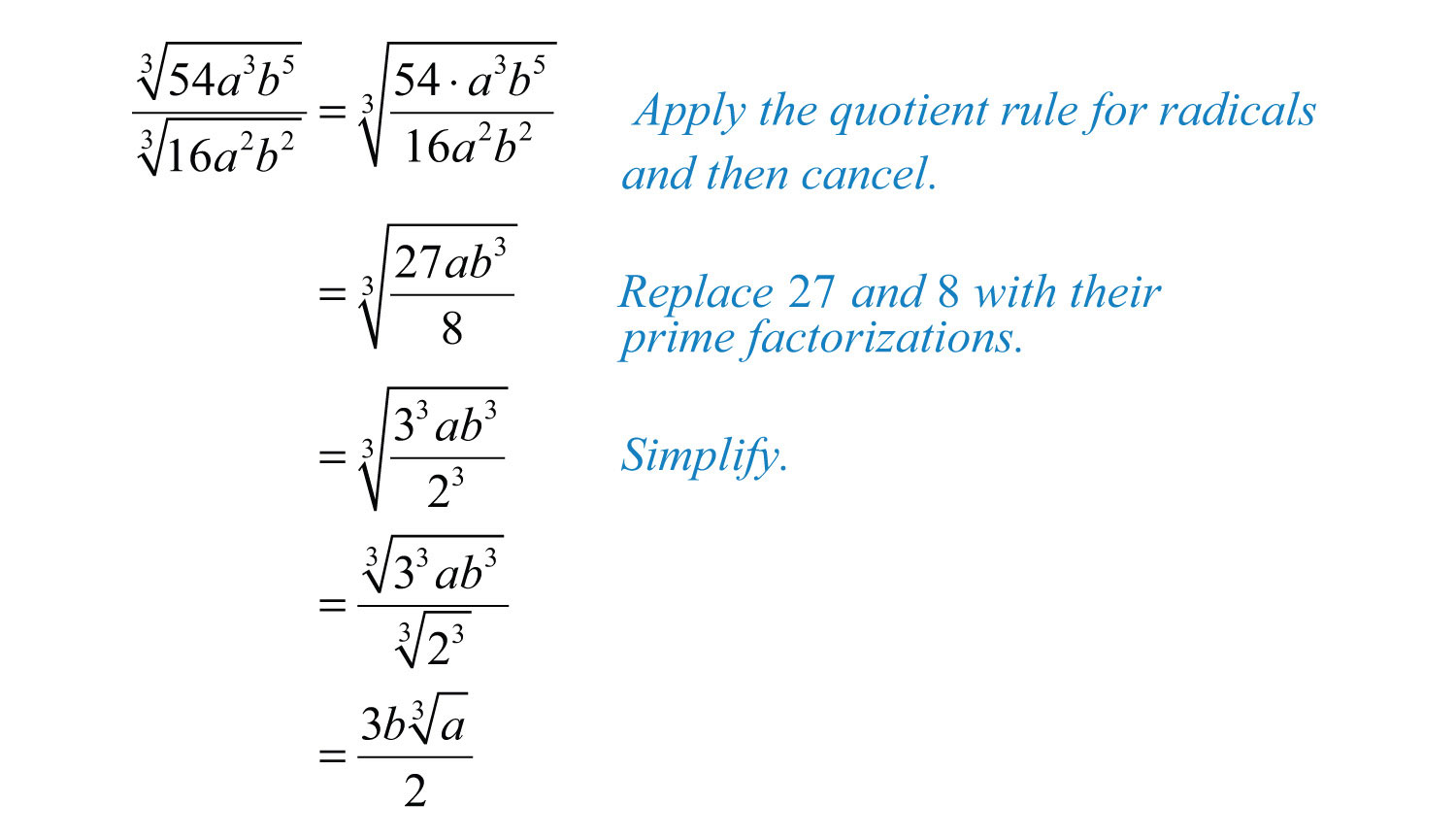
Answer:
When the divisor of a radical expression contains a radical, it is a common practice to find an equivalent expression where the denominator is a rational number. Finding such an equivalent expression is called rationalizing the denominatorThe process of determining an equivalent radical expression with a rational denominator..

To do this, multiply the fraction by a special form of 1 so that the radicand in the denominator can be written with a power that matches the index. After doing this, simplify and eliminate the radical in the denominator. For example,

Remember, to obtain an equivalent expression, you must multiply the numerator and denominator by the exact same nonzero factor.
Example 13: Rationalize the denominator: .
Solution: The goal is to find an equivalent expression without a radical in the denominator. In this example, multiply by 1 in the form .

Answer:
Example 14: Rationalize the denominator: .
Solution: The radicand in the denominator determines the factors that you need to use to rationalize it. In this example, multiply by 1 in the form .

Answer:
Typically, we will find the need to reduce, or cancel, after rationalizing the denominator.
Example 15: Rationalize the denominator: .
Solution: In this example, we will multiply by 1 in the form .

Notice that a and b do not cancel in this example. Do not cancel factors inside a radical with those that are outside.
Answer:
Try this! Rationalize the denominator: .
Answer:
Video Solution
(click to see video)Up to this point, we have seen that multiplying a numerator and a denominator by a square root with the exact same radicand results in a rational denominator. In general, this is true only when the denominator contains a square root. However, this is not the case for a cube root. For example,

Note that multiplying by the same factor in the denominator does not rationalize it. In this case, if we multiply by 1 in the form of , then we can write the radicand in the denominator as a power of 3. Simplifying the result then yields a rationalized denominator. For example,

Therefore, to rationalize the denominator of radical expressions with one radical term in the denominator, begin by factoring the radicand of the denominator. The factors of this radicand and the index determine what we should multiply by. Multiply numerator and denominator by the nth root of factors that produce nth powers of all the factors in the radicand of the denominator.
Example 16: Rationalize the denominator: .
Solution: The radical in the denominator is equivalent to . To rationalize the denominator, it should be . To obtain this, we need one more factor of 5. Therefore, multiply by 1 in the form of .

Answer:
Example 17: Rationalize the denominator: .
Solution: In this example, we will multiply by 1 in the form .
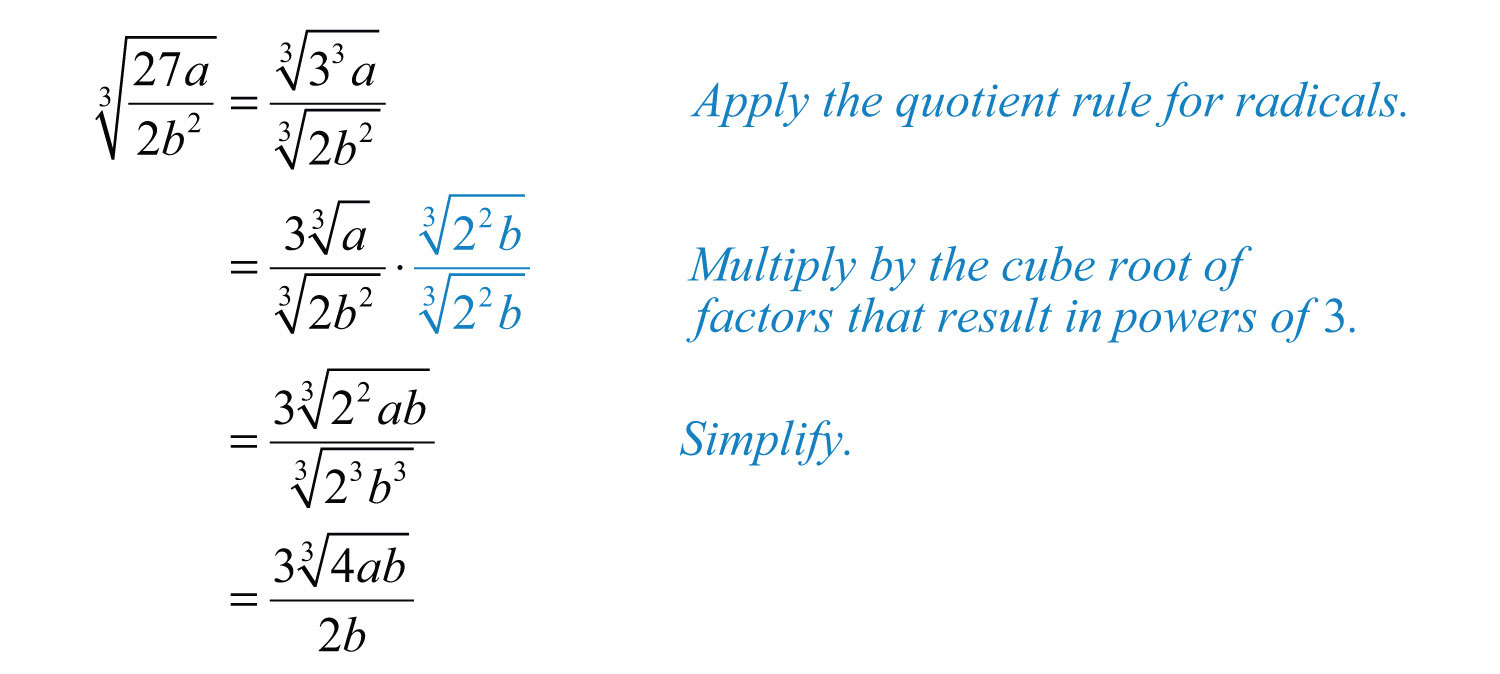
Answer:
Example 18: Rationalize the denominator: .
Solution: In this example, we will multiply by 1 in the form .

Answer:
When two terms involving square roots appear in the denominator, we can rationalize it using a very special technique. This technique involves multiplying the numerator and the denominator of the fraction by the conjugate of the denominator. Recall that multiplying a radical expression by its conjugate produces a rational number.
Example 19: Rationalize the denominator: .
Solution: In this example, the conjugate of the denominator is . Therefore, multiply by 1 in the form .
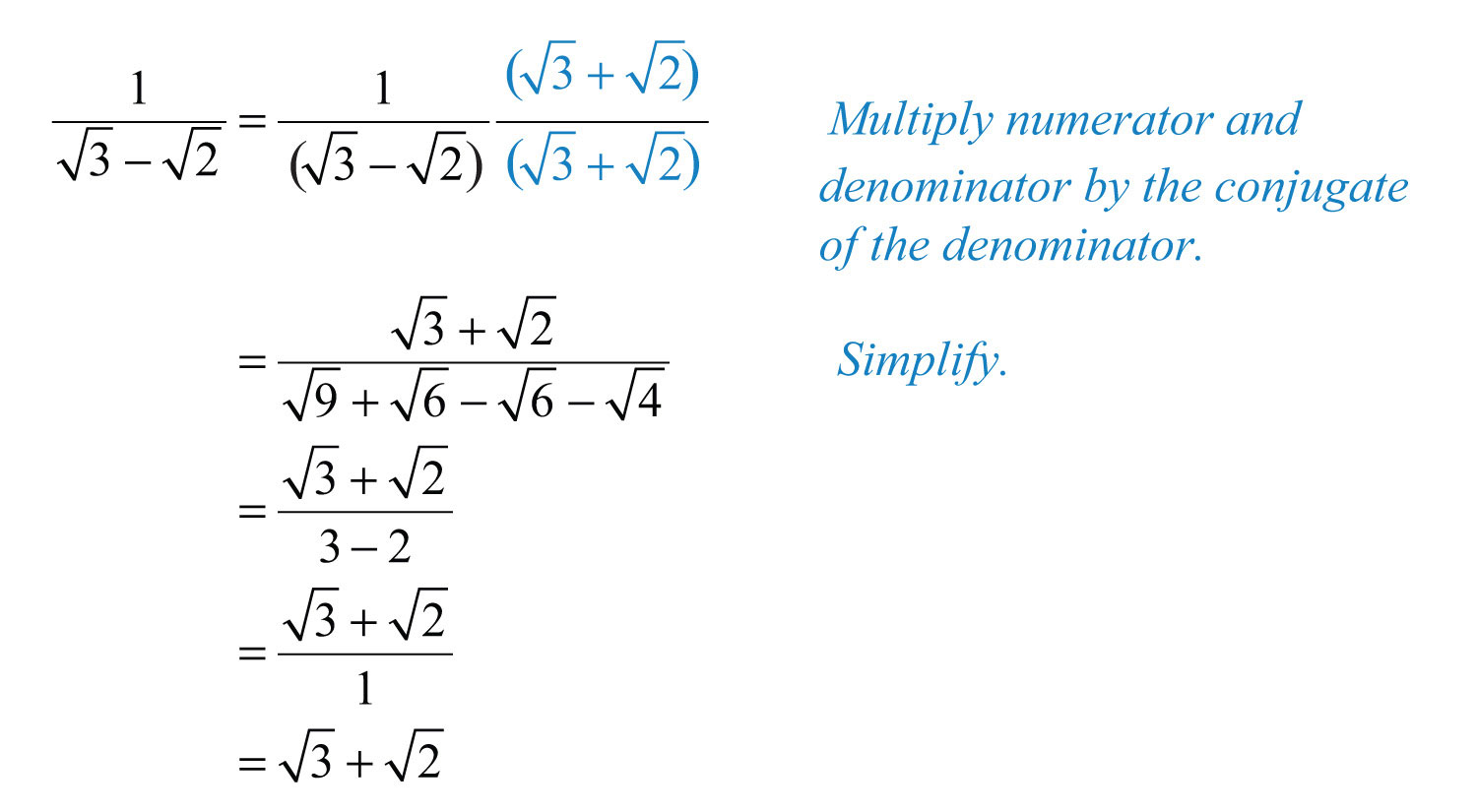
Answer:
Notice that the terms involving the square root in the denominator are eliminated by multiplying by the conjugate. We can use the property to expedite the process of multiplying the expressions in the denominator.
Example 20: Rationalize the denominator: .
Solution: Multiply by 1 in the form .

Answer:
Example 21: Rationalize the denominator: .
Solution: In this example, we will multiply by 1 in the form .
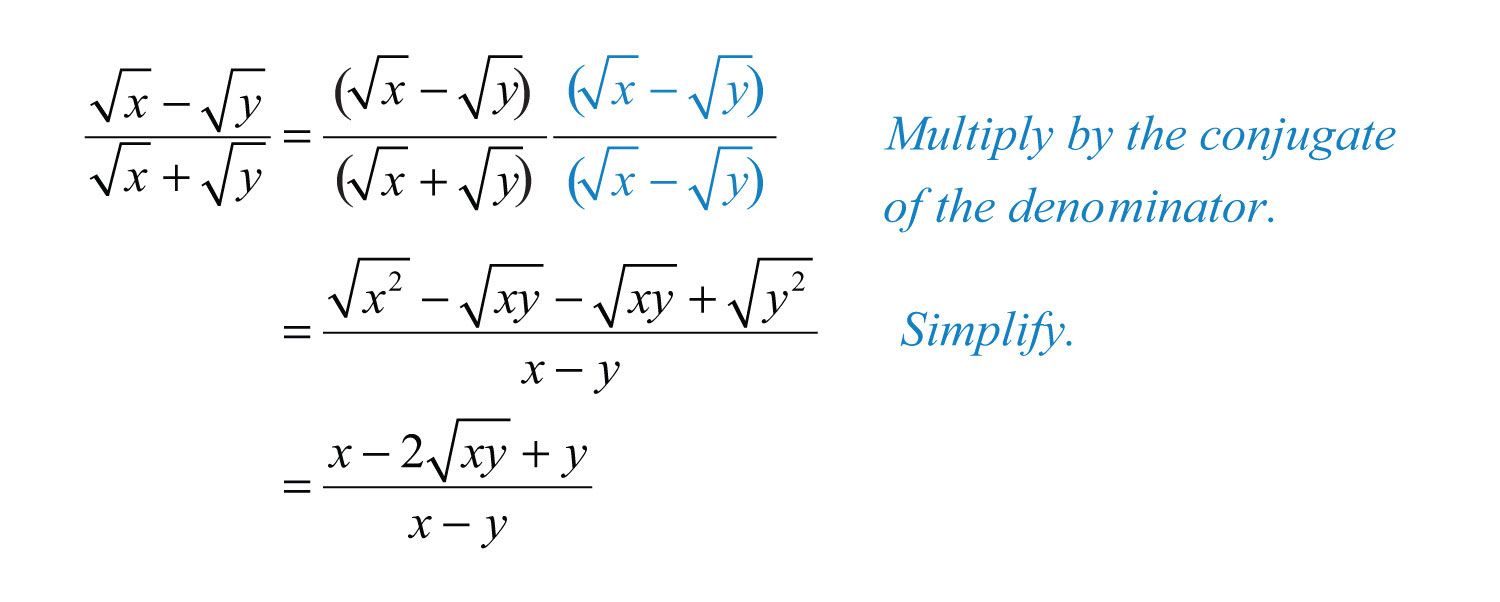
Answer:
Try this! Rationalize the denominator: .
Answer:
Video Solution
(click to see video)Key Takeaways
- To multiply two single-term radical expressions, multiply the coefficients and multiply the radicands. If possible, simplify the result.
- Apply the distributive property when multiplying radical expressions with multiple terms. Then simplify and combine all like radicals.
- Multiplying a two-term radical expression involving square roots by its conjugate results in a rational expression.
- It is common practice to write radical expressions without radicals in the denominator. The process of finding such an equivalent expression is called rationalizing the denominator.
- If an expression has one term in the denominator involving a radical, then rationalize it by multiplying numerator and denominator by the nth root of factors of the radicand so that their powers equal the index.
- If a radical expression has two terms in the denominator involving square roots, then rationalize it by multiplying the numerator and denominator by its conjugate.
Topic Exercises
Part A: Multiplying Radical Expressions
Multiply. (Assume all variables are nonnegative.)
1.
2.
3.
4.
5.
6.
7.
8.
9.
10.
11.
12.
13.
14.
15.
16.
17.
18.
19.
20.
21.
22.
23.
24.
25.
26.
27.
28.
29.
30.
31.
32.
33.
34.
35.
36.
37.
38.
39.
40.
41.
42.
43.
44.
45.
46.
47.
48.
49.
50.
51. What are the perimeter and area of a rectangle with length of centimeters and width of centimeters?
52. What are the perimeter and area of a rectangle with length of centimeters and width of centimeters?
53. If the base of a triangle measures meters and the height measures meters, then what is the area?
54. If the base of a triangle measures meters and the height measures meters, then what is the area?
Part B: Dividing Radical Expressions
Divide.
55.
56.
57.
58.
59.
60.
61.
62.
63.
64.
Rationalize the denominator.
65.
66.
67.
68.
69.
70.
71.
72.
73.
74.
75.
76.
77.
78.
79.
80.
81.
82.
83.
84.
85.
86.
87.
88.
89.
90.
91.
92.
93.
94.
95.
96.
97.
98.
99.
100.
101.
102.
103.
104.
105.
106.
Part C: Discussion
107. Research and discuss some of the reasons why it is a common practice to rationalize the denominator.
108. Explain in your own words how to rationalize the denominator.
Answers
1:
3:
5: 7
7:
9: 20
11:
13:
15:
17: 5
19:
21:
23: 16
25:
27:
29:
31:
33:
35:
37:
39:
41:
43:
45:
47: 10
49:
51: Perimeter: centimeters; area: square centimeters
53: 18 square meters
55: 5
57:
59:
61:
63:
65:
67:
69:
71:
73:
75:
77:
79:
81:
83:
85:
87:
89:
91:
93:
95:
97:
99:
101:
103:
105:
8.5 Rational Exponents
Learning Objectives
- Write expressions with rational exponents in radical form.
- Write radical expressions with rational exponents.
- Perform operations and simplify expressions with rational exponents.
- Perform operations on radicals with different indices.
Definition of Rational Exponents
So far, exponents have been limited to integers. In this section, we will define what rational (or fractional) exponentsThe fractional exponent m/n that indicates a radical with index n and exponent m: . mean and how to work with them. All of the rules for exponents developed up to this point apply. In particular, recall the product rule for exponents. Given any rational numbers m and n, then

For example, if we have an exponent of , then the product rule for exponents implies the following:

Here is one of two equal factors of 5; hence it is a square root of 5, and we can write

Furthermore, we can see that is one of three equal factors of 2.

Therefore, is the cube root of 2, and we can write

This is true in general, given any nonzero real number a,

In other words, the denominator of a fractional exponent determines the index of an nth root.
Example 1: Rewrite as a radical.
a.
b.
Solution:
a.
b.
Example 2: Rewrite as a radical and then simplify.
a.
b.
Solution:
a.
b.
Example 3: Rewrite as a radical and then simplify.
a.
b.
Solution:
a.

b.

Next, consider fractional exponents where the numerator is an integer other than 1. For example, consider the following:

This shows that is one of three equal factors of . In other words, is the cube root of and we can write:

In general, given any real number a,

An expression with a rational exponent is equivalent to a radical where the denominator is the index and the numerator is the exponent. Any radical expression can be written with a rational exponent, which we call exponential formAn equivalent expression written using a rational exponent..

Example 4: Rewrite as a radical.
a.
b.
Solution:
a.
b.
Example 5: Rewrite as a radical and then simplify.
a.
b.
Solution:
a.

b. We can often avoid very large integers by working with their prime factorization.
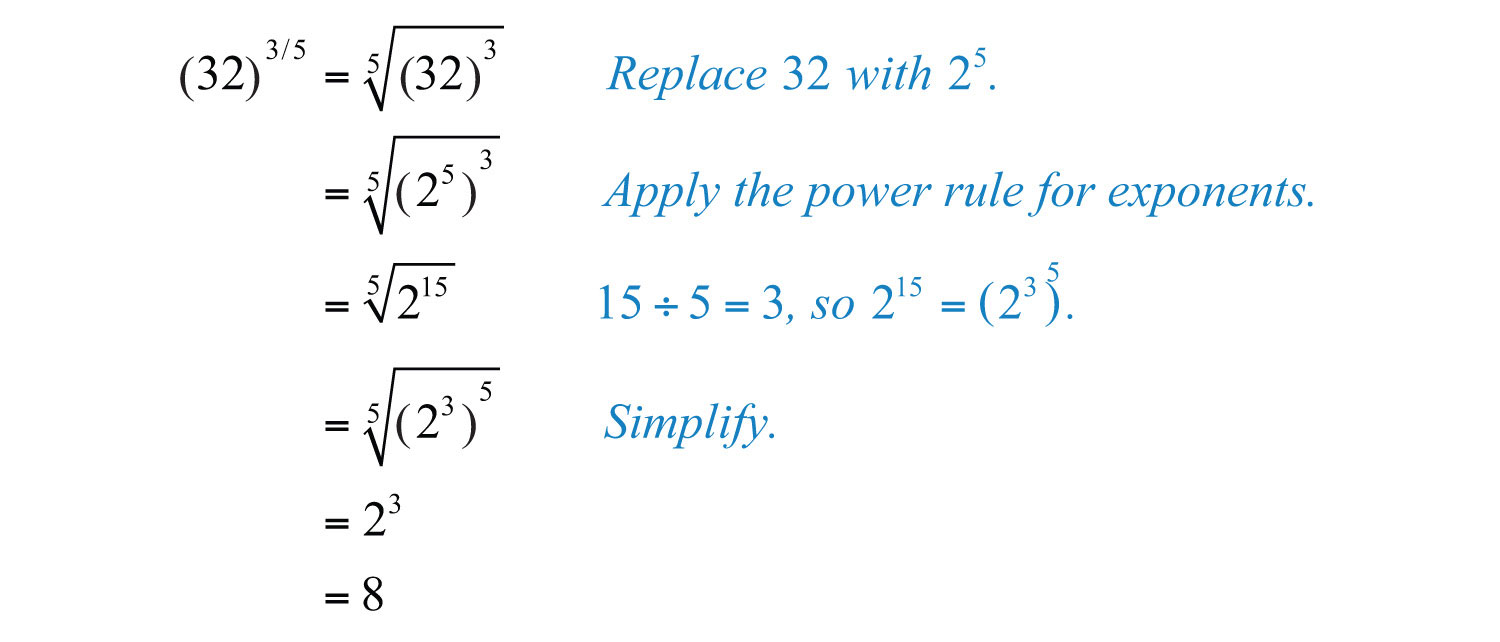
Given a radical expression, we will be asked to find the equivalent in exponential form. Assume all variables are positive.
Example 6: Rewrite using rational exponents: .
Solution: Here the index is 3 and the power is 2. We can write

Answer:
Example 7: Rewrite using rational exponents: .
Solution: Here the index is 6 and the power is 3. We can write

Answer:
It is important to note that the following are equivalent.

In other words, it does not matter if we apply the power first or the root first. For example, we can apply the power before the root:

Or we can apply the nth root before the power:

The results are the same.
Example 8: Rewrite as a radical and then simplify: .
Solution: Here the index is 3 and the power is 2. We can write

Answer: 4
Try this! Rewrite as a radical and then simplify: .
Answer: 125
Video Solution
(click to see video)Some calculators have a caret button . If so, we can calculate approximations for radicals using it and rational exponents. For example, to calculate , we would type

To calculate , we would type

Operations Using the Rules of Exponents
In this section, we review all of the rules of exponents, which extend to include rational exponents. If given any rational numbers m and n, then we have
| Product rule: | |
| Quotient rule: | |
| Power rule: | |
| Power rule for a product: | |
| Power rule for a quotient: | |
| Negative exponents: | |
| Zero exponent: |
These rules allow us to perform operations with rational exponents.
Example 9: Simplify: .
Solution:

Answer:
Example 10: Simplify: .
Solution:

Answer:
Example 11: Simplify: .
Solution:

Answer:
Example 12: Simplify: .
Solution:

Answer:
Example 13: Simplify: .
Solution:
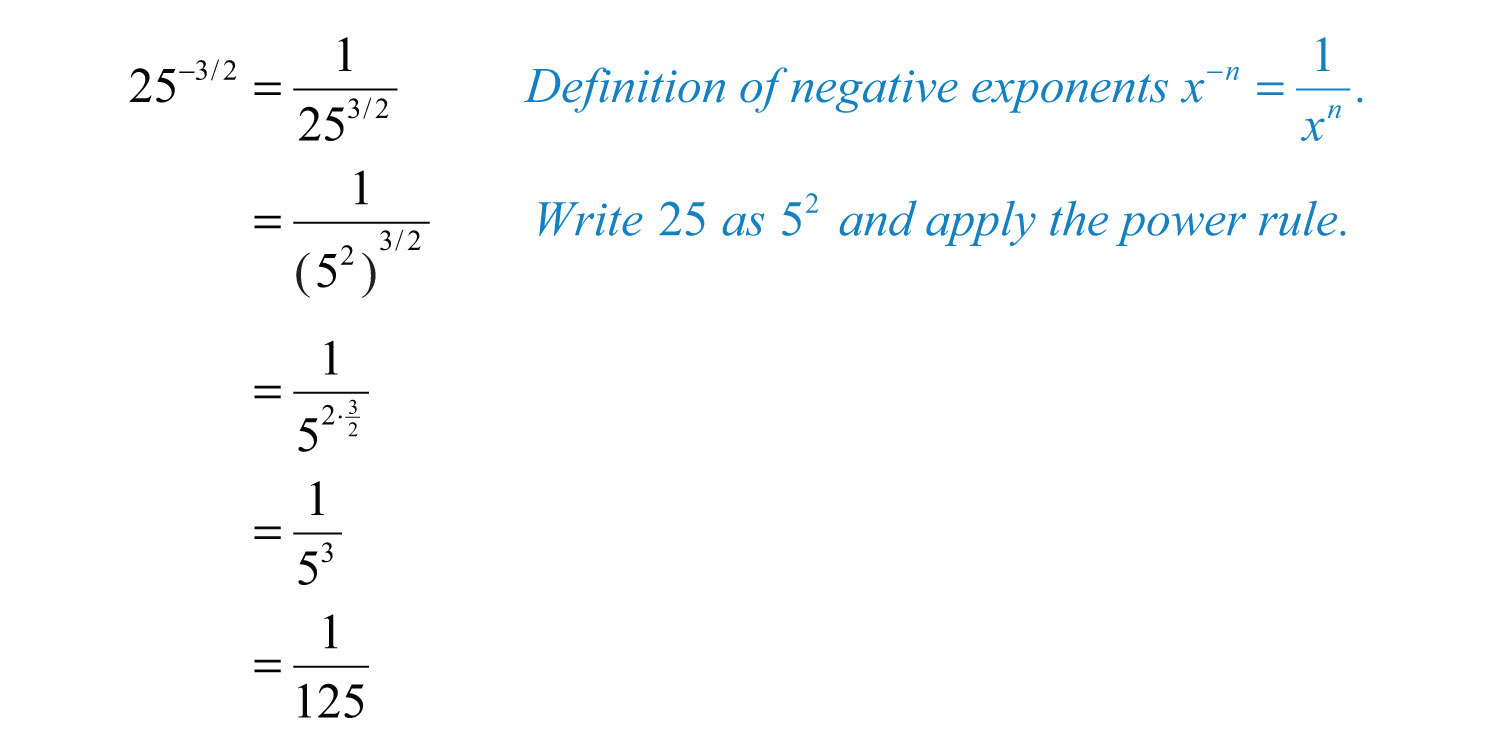
Answer: 1/125
Try this! Simplify: .
Answer:
Video Solution
(click to see video)Radical Expressions with Different Indices
To apply the product or quotient rule for radicals, the indices of the radicals involved must be the same. If the indices are different, then first rewrite the radicals in exponential form and then apply the rules for exponents.
Example 14: Multiply: .
Solution: In this example, the index of each radical factor is different. Hence the product rule for radicals does not apply. Begin by converting the radicals into an equivalent form using rational exponents. Then apply the product rule for exponents.
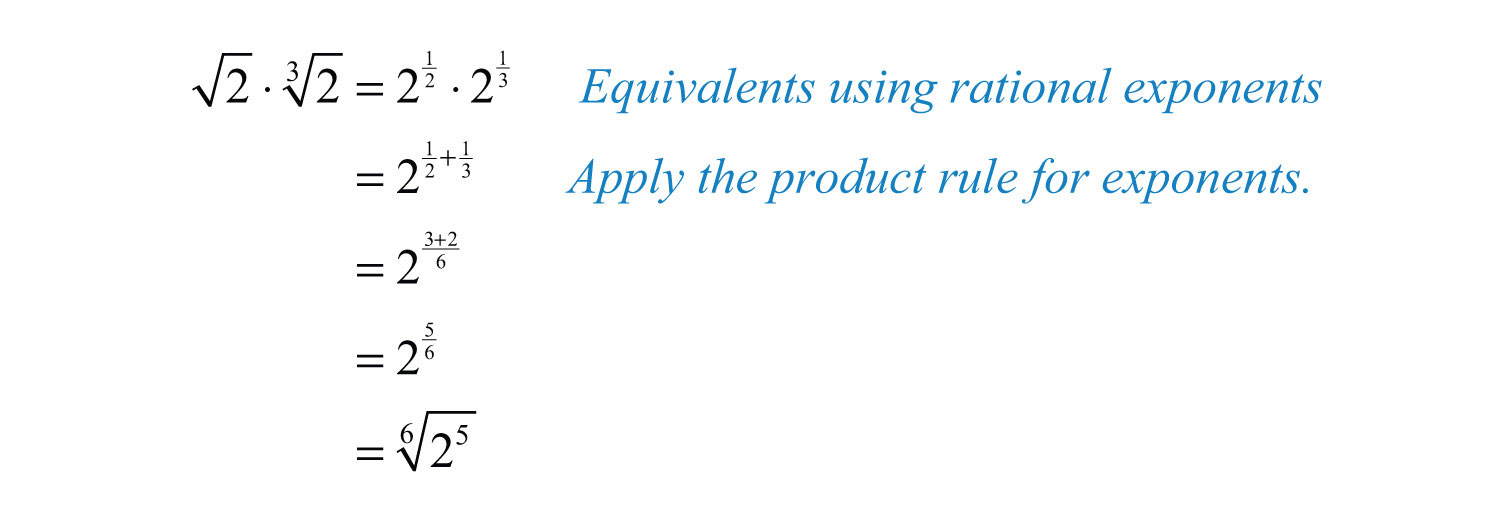
Answer:
Example 15: Divide: .
Solution: In this example, the index of the radical in the numerator is different from the index of the radical in the denominator. Hence the quotient rule for radicals does not apply. Begin by converting the radicals into an equivalent form using rational exponents and then apply the quotient rule for exponents.

Answer:
Example 16: Simplify: .
Solution: Here the radicand of the square root is a cube root. After rewriting this expression using rational exponents, we will see that the power rule for exponents applies.
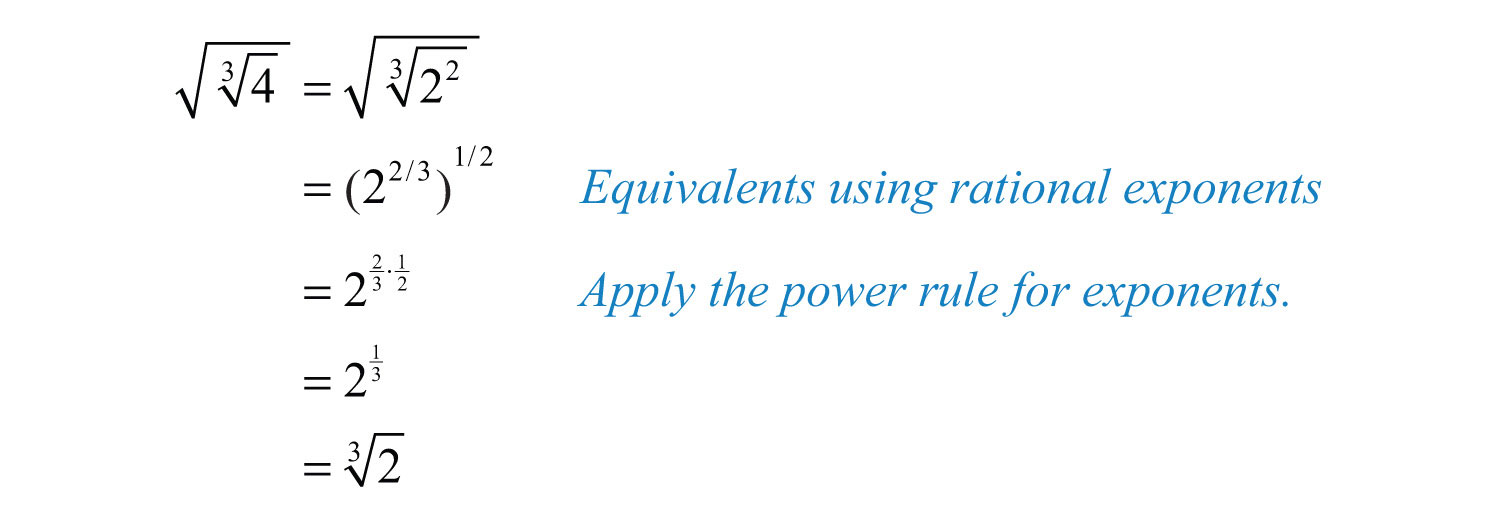
Answer:
Key Takeaways
- When converting fractional exponents to radicals, use the numerator as the power and the denominator as the index of the radical.
- All the rules of exponents apply to expressions with rational exponents.
Topic Exercises
Part A: Rational Exponents
Express using rational exponents.
1.
2.
3.
4.
5.
6.
7.
8.
9.
10.
Express in radical form.
11.
12.
13.
14.
15.
16.
17.
18.
19.
20.
Write as a radical and then simplify.
21.
22.
23.
24.
25.
26.
27.
28.
29.
30.
31.
32.
33.
34.
35.
36.
37.
38.
39.
40.
41.
42.
43.
44.
45.
46.
47.
48.
49.
50.
51.
52.
53.
54.
55.
56.
Use a calculator to approximate an answer rounded to the nearest hundredth.
57.
58.
59.
60.
61.
62.
63. Explain why (−4)^(3/2) gives an error on a calculator and −4^(3/2) gives an answer of −8.
64. Marcy received a text message from Mark asking her how old she was. In response, Marcy texted back “125^(2/3) years old.” Help Mark determine how old Marcy is.
Part B: Rational Exponents
Perform the operations and simplify. Leave answers in exponential form.
65.
66.
67.
68.
69.
70.
71.
72.
73.
74.
75.
76.
77.
78.
79.
80.
81.
82.
83.
84.
85.
86.
87.
88.
89.
90.
91.
92.
93.
94.
95.
96.
Part C: Mixed Indices
Perform the operations.
97.
98.
99.
100.
101.
102.
103.
104.
105.
106.
107.
108.
109.
110.
111.
112.
113.
114.
Part D: Discussion Board
115. Who is credited for devising the notation for rational exponents? What are some of his other accomplishments?
116. When using text, it is best to communicate nth roots using rational exponents. Give an example.
Answers
1:
3:
5:
7:
9:
11:
13:
15:
17:
19:
21: 5
23: 11
25: 1/2
27: 1/2
29: 2
31: 2
33: 1/3
35: −3
37: 2
39: 1/3
41: 10
43: 1/2
45: 27
47: 32
49: 64
51: 1/8
53: 9
55: −8
57: 1.68
59: 1.38
61: Not a real number
63: In the first expression, the square root of a negative number creates an error condition on the calculator. The square root of a negative number is not real. In the second expression, because of the order of operations, the negative sign is applied to the answer after 4 is raised to the (3/2) power.
65: 4
67:
69:
71: 25
73:
75: 2
77:
79:
81:
83:
85:
87:
89:
91:
93:
95:
97:
99:
101:
103:
105:
107:
109:
111:
113:
8.6 Solving Radical Equations
Learning Objectives
- Solve equations involving square roots.
- Solve equations involving cube roots.
Radical Equations
A radical equationAny equation that contains one or more radicals with a variable in the radicand. is any equation that contains one or more radicals with a variable in the radicand. Following are some examples of radical equations, all of which will be solved in this section:

We begin with the squaring property of equalityGiven real numbers a and b, where , then .; given real numbers a and b, we have the following:

In other words, equality is retained if we square both sides of an equation.

The converse, on the other hand, is not necessarily true:

This is important because we will use this property to solve radical equations. Consider a very simple radical equation that can be solved by inspection:

Here we can see that is a solution. To solve this equation algebraically, make use of the squaring property of equality and the fact that when a is positive. Eliminate the square root by squaring both sides of the equation as follows:

As a check, we can see that as expected. Because the converse of the squaring property of equality is not necessarily true, solutions to the squared equation may not be solutions to the original. Hence squaring both sides of an equation introduces the possibility of extraneous solutionsA solution that does not solve the original equation., or solutions that do not solve the original equation. For this reason, we must check the answers that result from squaring both sides of an equation.
Example 1: Solve: .
Solution: We can eliminate the square root by applying the squaring property of equality.

Next, we must check.

Answer: The solution is 26.
Example 2: Solve: .
Solution: Begin by squaring both sides of the equation.

You are left with a quadratic equation that can be solved by factoring.
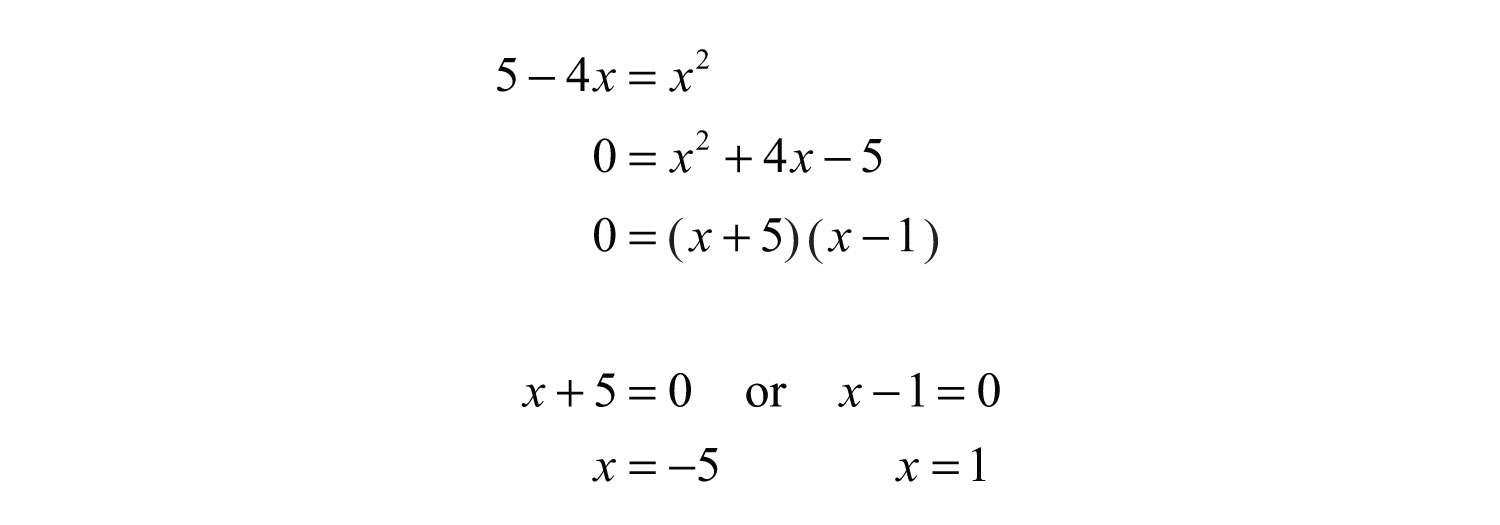
Since you squared both sides, you must check your solutions.
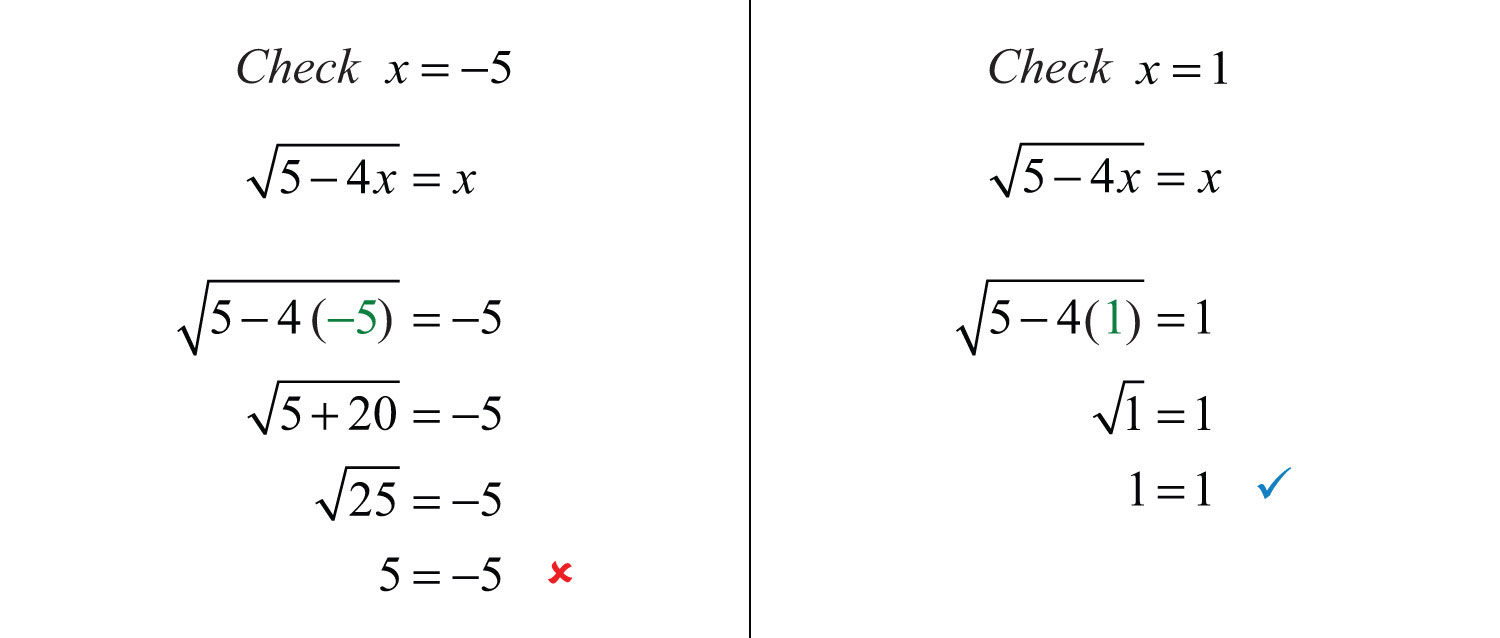
After checking, you can see that was extraneous; it did not solve the original radical equation. Disregard that answer. This leaves as the only solution.
Answer: The solution is .
In the previous two examples, notice that the radical is isolated on one side of the equation. Typically, this is not the case. The steps for solving radical equations involving square roots are outlined in the following example.
Example 3: Solve: .
Solution:
Step 1: Isolate the square root. Begin by subtracting 4 from both sides of the equation.

Step 2: Square both sides. Squaring both sides eliminates the square root.

Step 3: Solve the resulting equation. Here you are left with a quadratic equation that can be solved by factoring.
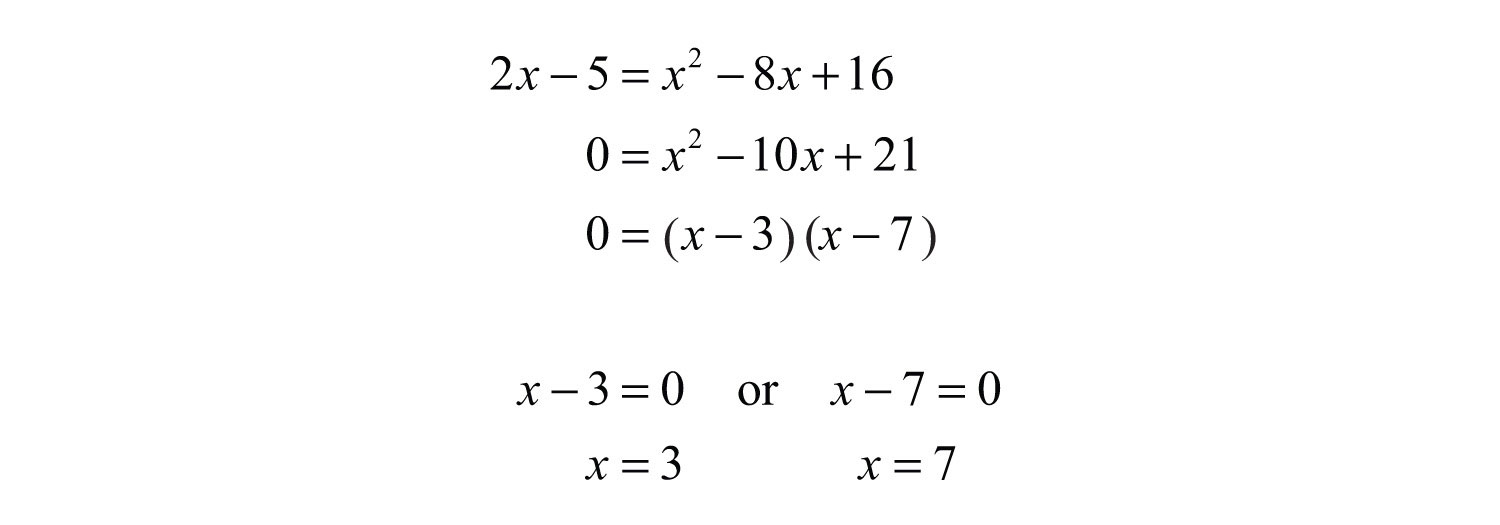
Step 4: Check the solutions in the original equation. Squaring both sides introduces the possibility of extraneous solutions; hence the check is required.
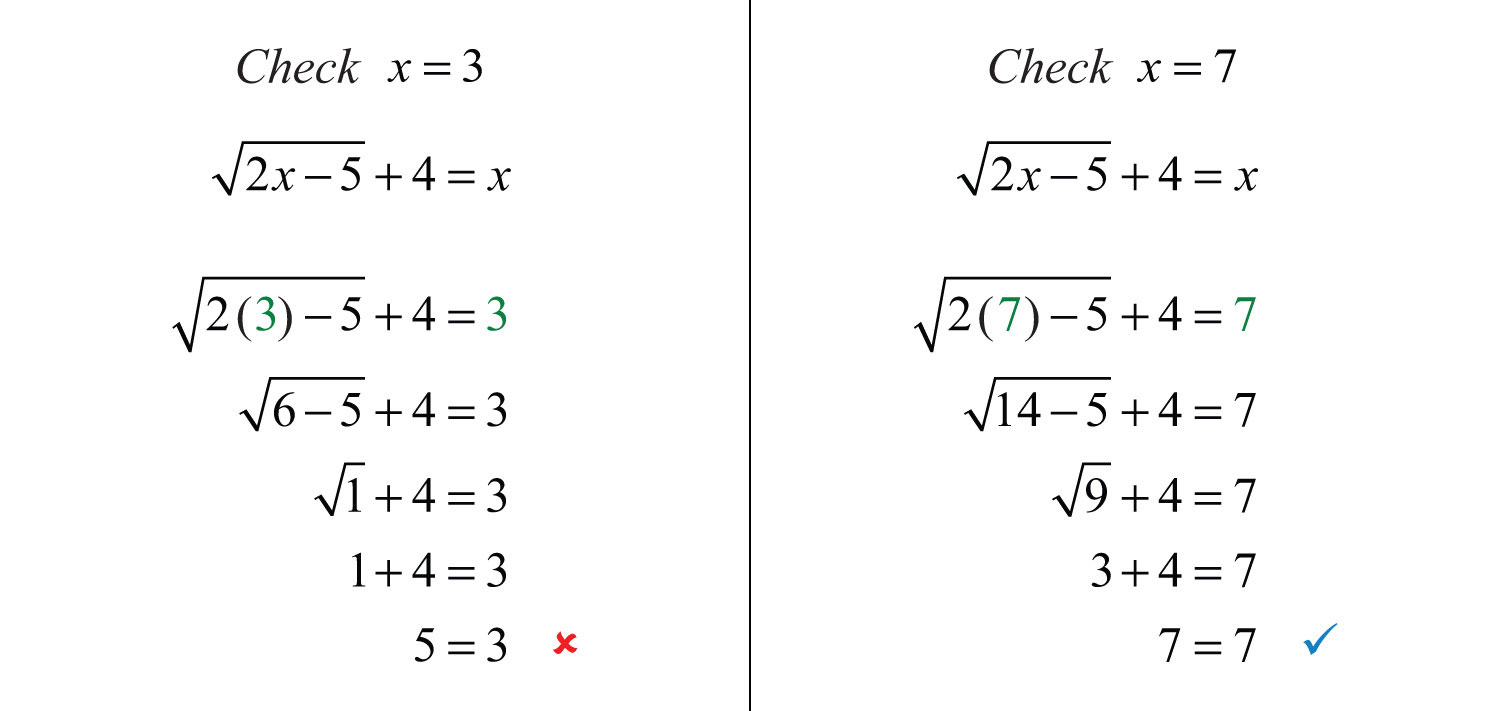
After checking, we can see that is an extraneous root; it does not solve the original radical equation. This leaves as the only solution.
Answer: The solution is .
Example 4: Solve: .
Solution: Begin by isolating the term with the radical.

Despite the fact that the term on the left side has a coefficient, it is still considered isolated. Recall that terms are separated by addition or subtraction operators.

Solve the resulting quadratic equation.
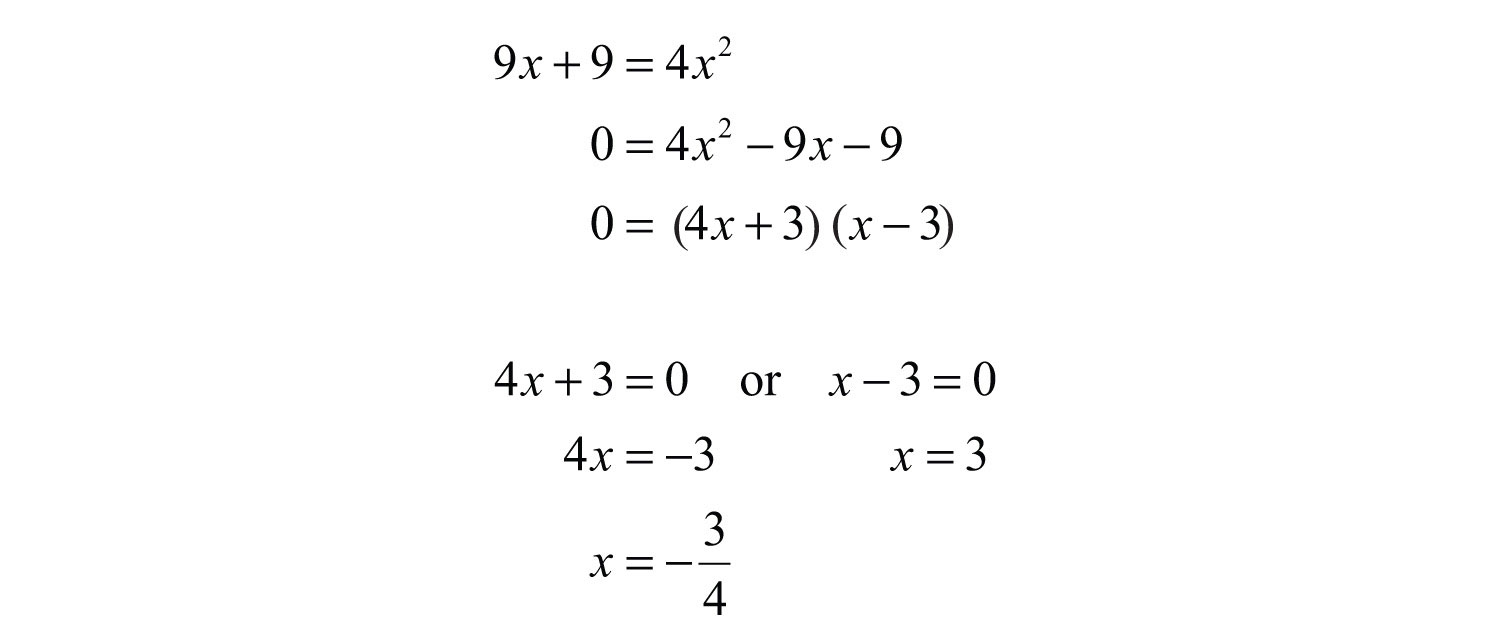
Since we squared both sides, we must check our solutions.
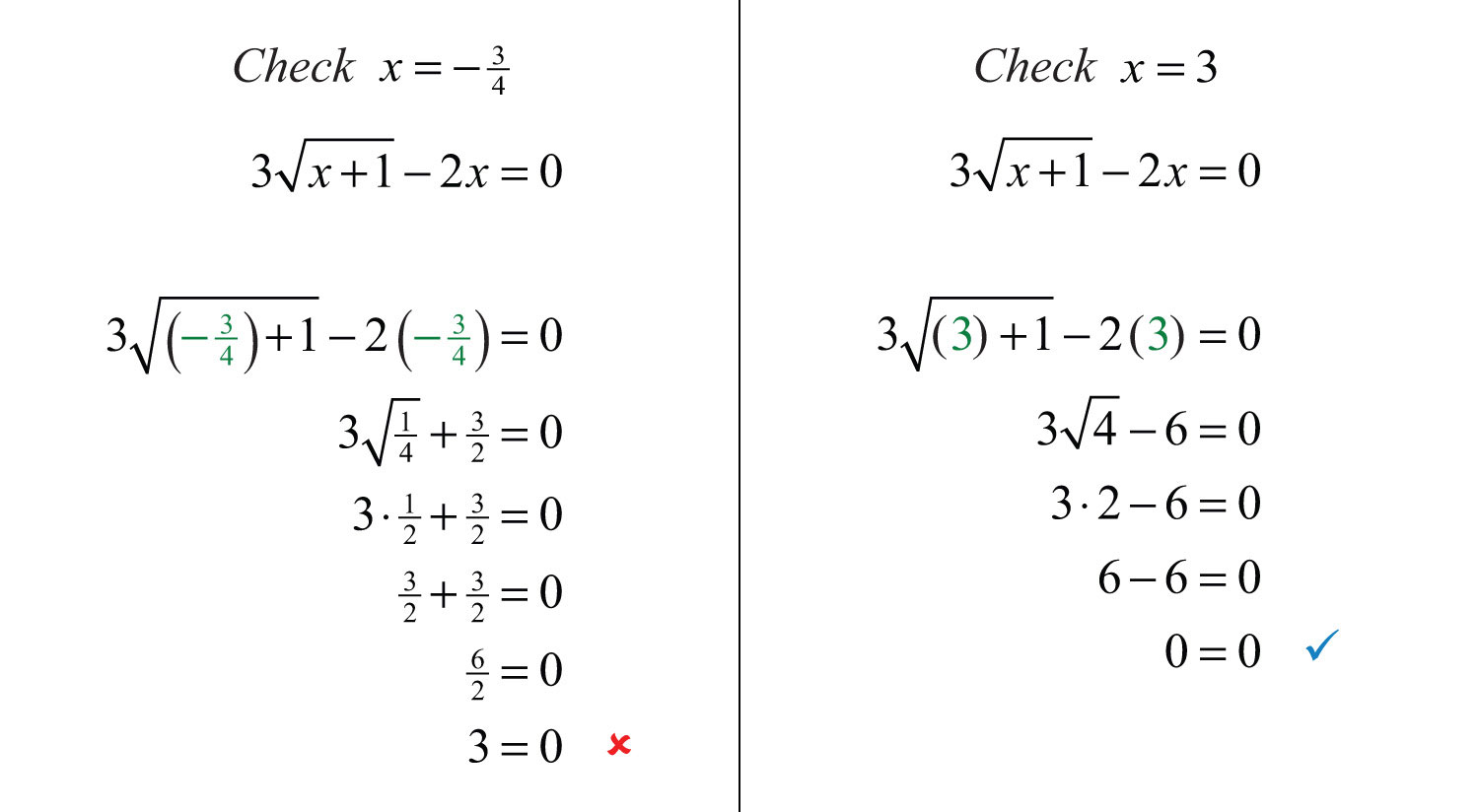
After checking, we can see that was extraneous.
Answer: The solution is 3.
Sometimes both of the possible solutions are extraneous.
Example 5: Solve: .
Solution: Begin by isolating the radical.
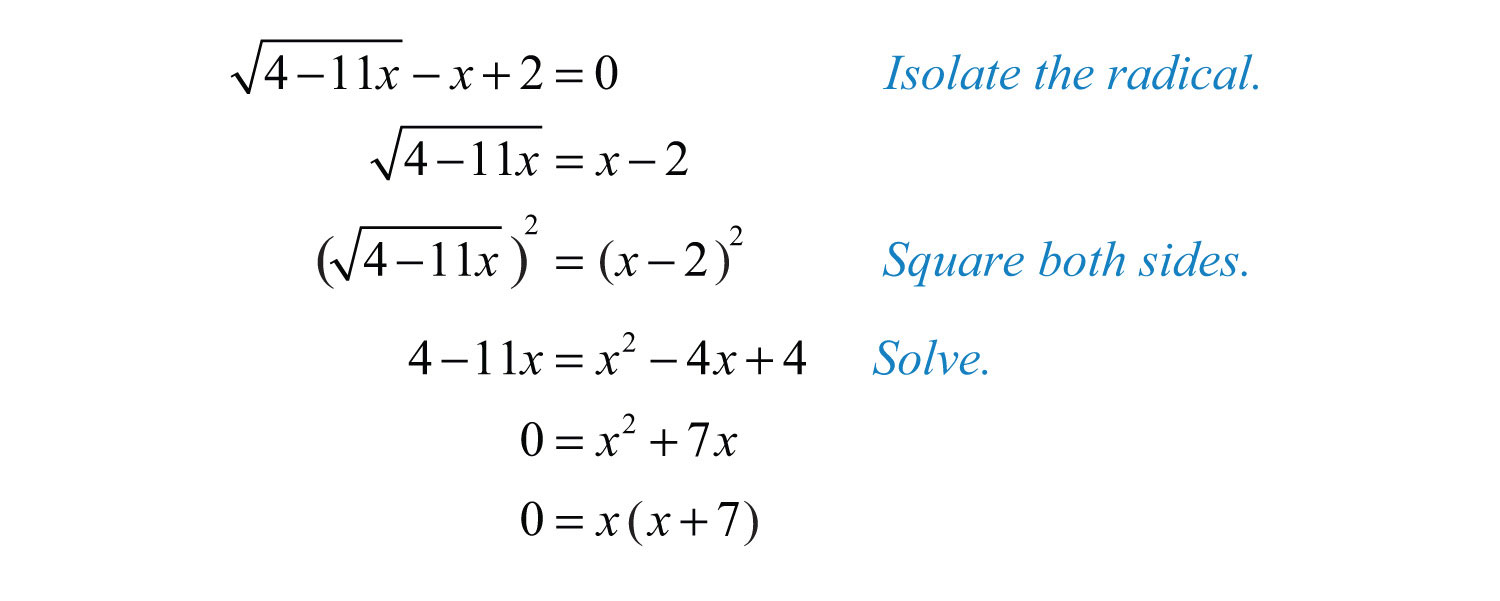
Since we squared both sides, we must check our solutions.
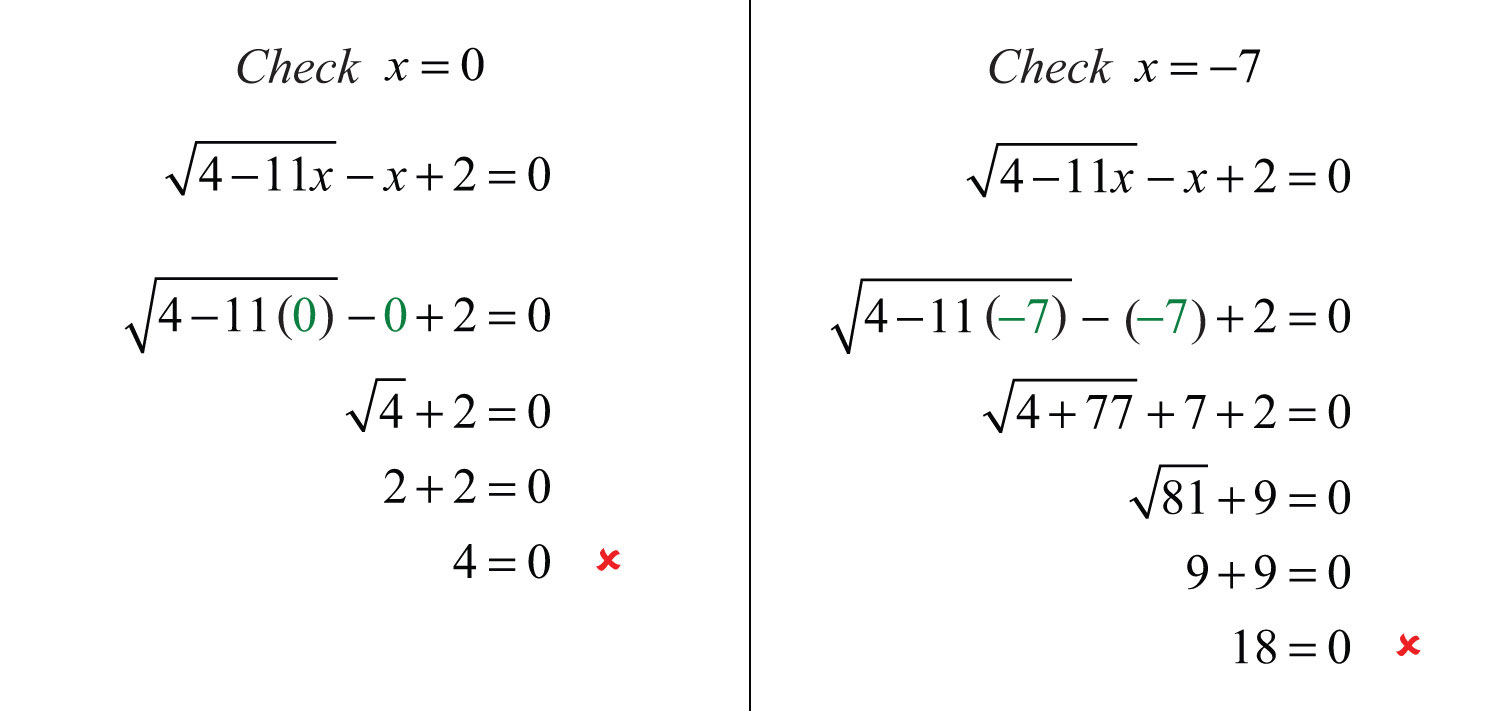
Since both possible solutions are extraneous, the equation has no solution.
Answer: No solution, Ø
The squaring property of equality extends to any positive integer power n. Given real numbers a and b, we have the following:

This is often referred to as the power property of equalityGiven any positive integer n and real numbers a and b, where , then .. Use this property, along with the fact that , when a is positive, to solve radical equations with indices greater than 2.
Example 6: Solve: .
Solution: Isolate the radical and then cube both sides of the equation.
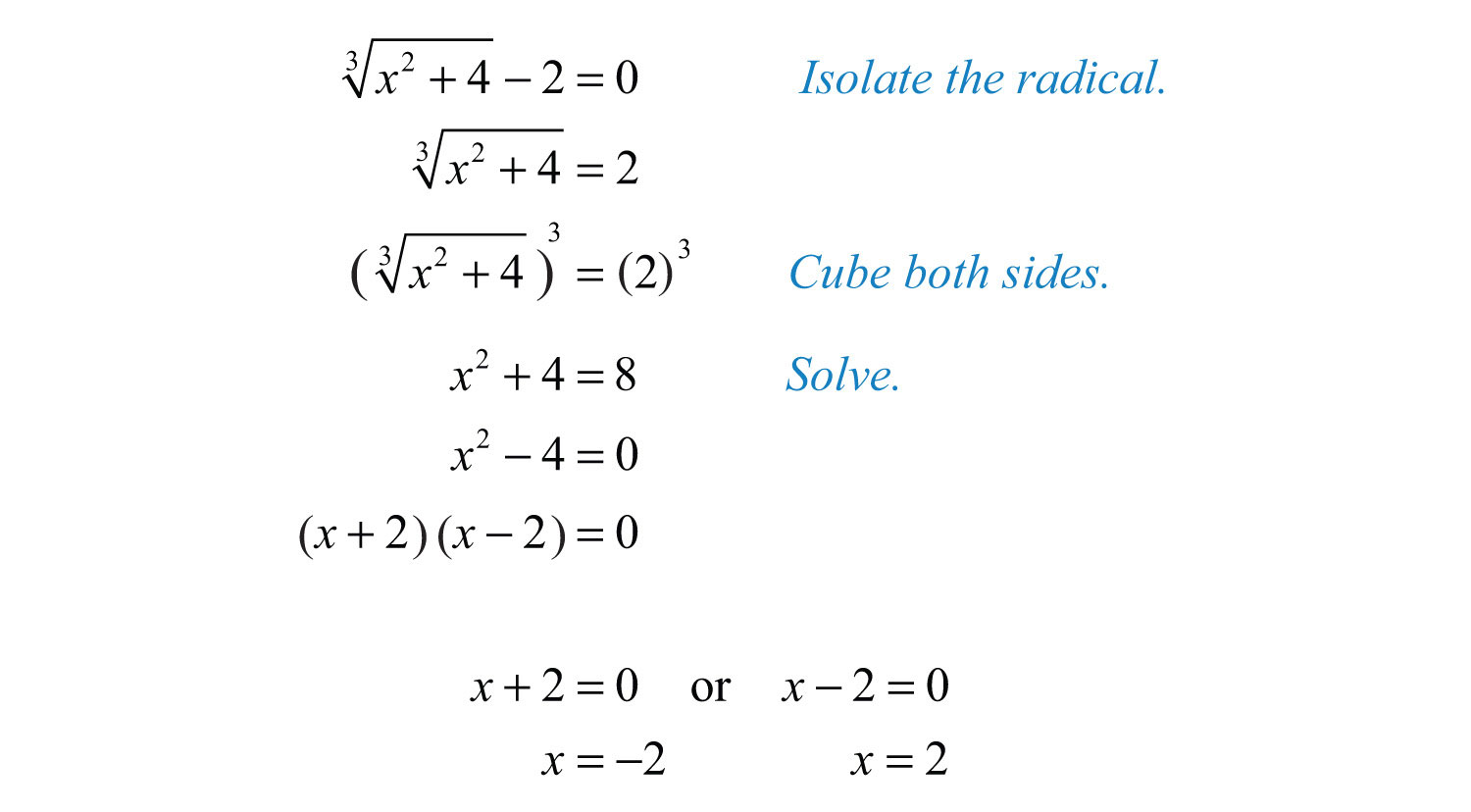
Check.
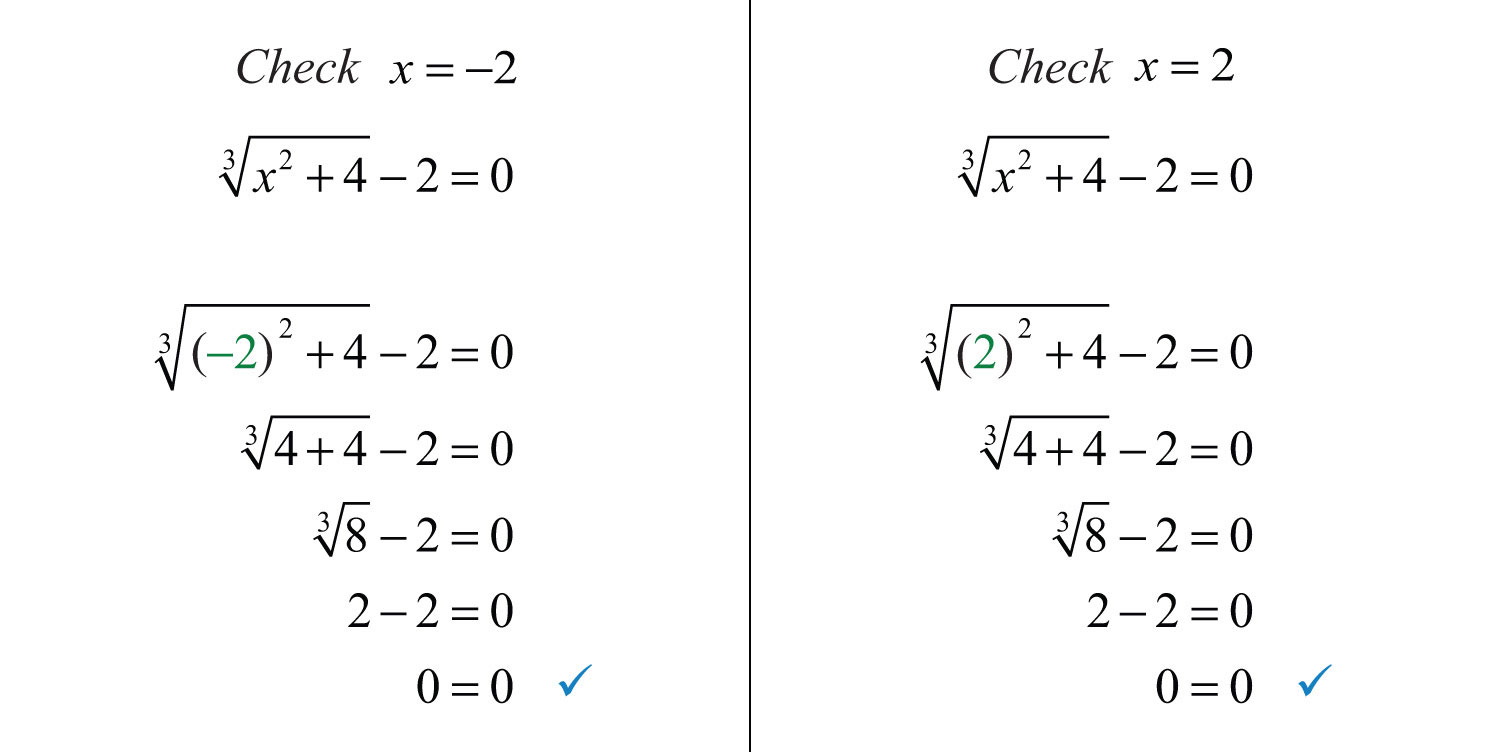
Answer: The solutions are −2 and 2.
Try this! Solve: .
Answer: ( is extraneous)
Video Solution
(click to see video)It may be the case that the equation has two radical expressions.
Example 7: Solve: .
Solution: Both radicals are considered isolated on separate sides of the equation.

Check .

Answer: The solution is 13.
Example 8: Solve: .
Solution: Eliminate the radicals by cubing both sides.
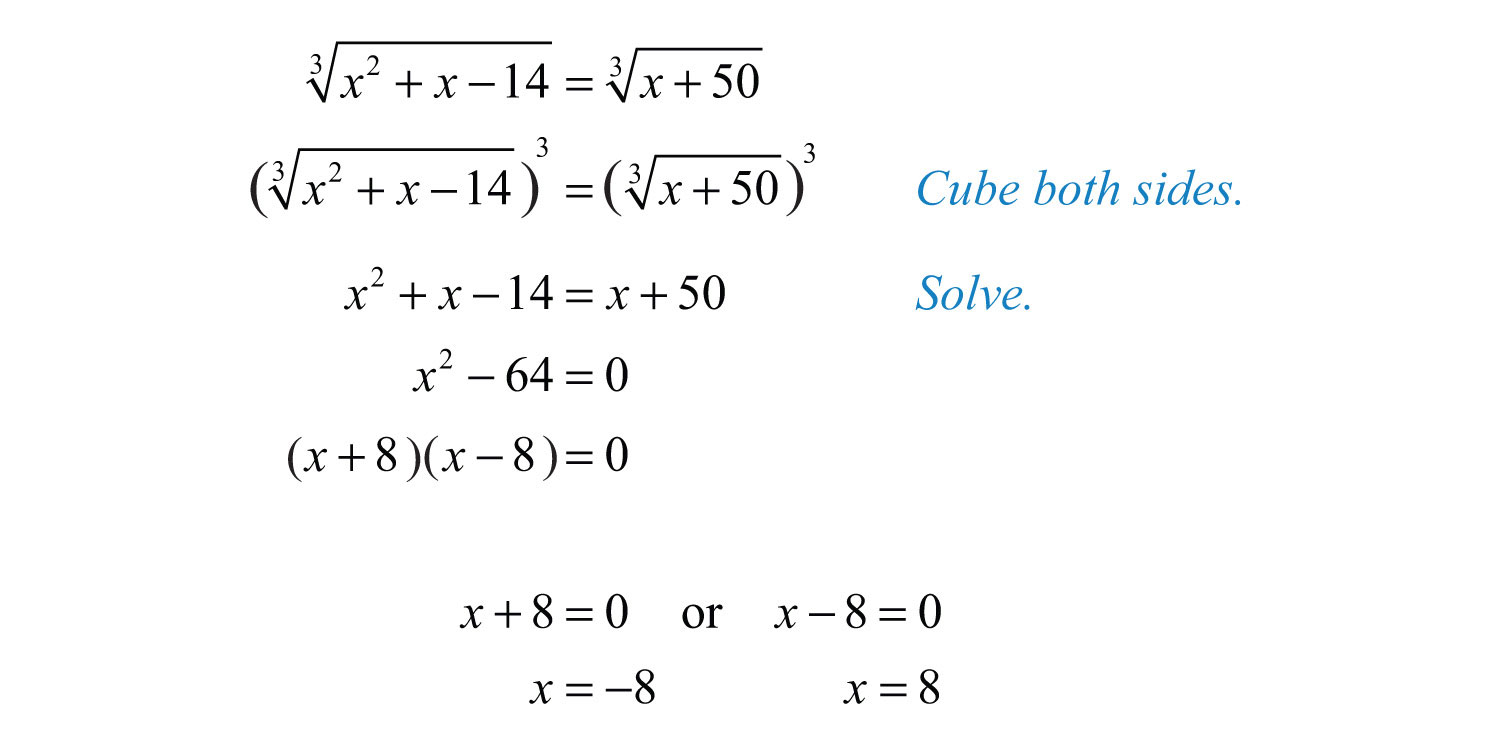
Check.
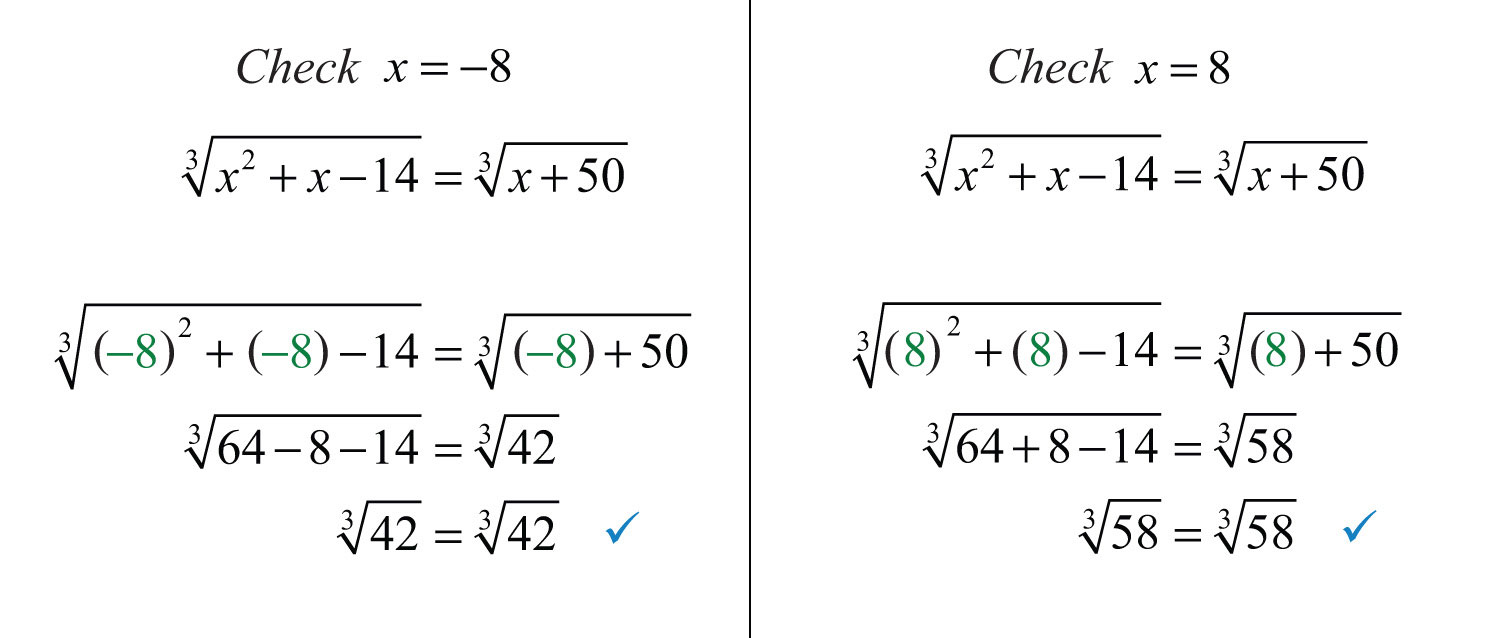
Answer: The solutions are −8 and 8.
We will learn how to solve some of the more advanced radical equations in the next course, Intermediate Algebra.
Try this! Solve: .
Answer: 13
Video Solution
(click to see video)Key Takeaways
- Solve equations involving square roots by first isolating the radical and then squaring both sides. Squaring a square root eliminates the radical, leaving us with an equation that can be solved using the techniques learned earlier in our study of algebra. However, squaring both sides of an equation introduces the possibility of extraneous solutions, so check your answers in the original equation.
- Solve equations involving cube roots by first isolating the radical and then cubing both sides. This eliminates the radical and results in an equation that may be solved with techniques you have already mastered.
Topic Exercises
Part A: Solving Radical Equations
Solve.
1.
2.
3.
4.
5.
6.
7.
8.
9.
10.
11.
12.
13.
14.
15.
16.
17.
18.
19.
20.
21.
22.
23.
24.
25.
26.
27.
28.
29.
30.
31.
32.
33.
34.
35.
36.
37.
38.
39.
40.
41.
42.
43.
44.
45.
46.
47.
48.
49.
50.
51.
52.
53.
54.
55.
56.
57.
58.
59.
60.
61.
62.
63.
64.
65.
66.
67.
68.
69.
70.
71.
72.
73.
74.
75.
76.
77.
78.
79.
80.
81.
82.
83.
84.
85.
86.
87.
88.
89. The square root of 1 less than twice a number is equal to 2 less than the number. Find the number.
90. The square root of 4 less than twice a number is equal to 6 less than the number. Find the number.
91. The square root of twice a number is equal to one-half of that number. Find the number.
92. The square root of twice a number is equal to one-third of that number. Find the number.
93. The distance, d, measured in miles, a person can see an object is given by the formula
where h represents the person’s height above sea level, measured in feet. How high must a person be to see an object 5 miles away?
94. The current, I, measured in amperes, is given by the formula
where P is the power usage, measured in watts, and R is the resistance, measured in ohms. If a light bulb requires 1/2 ampere of current and uses 60 watts of power, then what is the resistance of the bulb?
The period, T, of a pendulum in seconds is given by the formula
where L represents the length in feet. For each problem below, calculate the length of a pendulum, given the period. Give the exact value and the approximate value rounded off to the nearest tenth of a foot.
95. 1 second
96. 2 seconds
97. 1/2 second
98. 1/3 second
The time, t, in seconds an object is in free fall is given by the formula
where s represents the distance in feet the object has fallen. For each problem below, calculate the distance an object falls, given the amount of time.
99. 1 second
100. 2 seconds
101. 1/2 second
102. 1/4 second
The x-intercepts for any graph have the form (x, 0), where x is a real number. Therefore, to find x-intercepts, set y = 0 and solve for x. Find the x-intercepts for each of the following.
103.
104.
105.
106.
Part B: Discussion Board
107. Discuss reasons why we sometimes obtain extraneous solutions when solving radical equations. Are there ever any conditions where we do not need to check for extraneous solutions? Why?
Answers
1: 4
3: 1
5: Ø
7: 1/25
9: 12
11: 1
13: 3
15: 13/4
17: 8
19: 9
21: −3
23: −15/8
25: 2
27: 7
29: 2
31: −3
33: 7
35: 2, 6
37: 2
39: −1, 8
41: 5
43: Ø
45: −3, 3
47: 2, 5
49: −4, −4
51: 1/2
53: 2, 7
55: Ø
57: 10
59: −6, −4
61: −1/2, 3/2
63: Ø
65: −5, 5
67: −9, 3
69: 1/5
71: 5, 10
73: −7, 7
75: 100
77: −8
79: 10
81: −13
83: 5/2
85: −6, −4
87: −2, 2
89: 5
91: 8
93: feet
95: foot
97: foot
99: 16 feet
101: 4 feet
103: (4, 0)
105: (−7, 0)
8.7 Review Exercises and Sample Exam
Review Exercises
(Assume all variables represent nonnegative numbers.)
Radicals
Simplify.
1.
2.
3.
4.
5.
6.
7.
8.
9.
10.
11.
12.
13.
14.
Simplifying Radical Expressions
Simplify.
15.
16.
17.
18.
19.
20.
21.
22.
23.
24.
Use the distance formula to calculate the distance between the given two points.
25. (5, −8) and (2, −10)
26. (−7, −1) and (−6, 1)
27. (−10, −1) and (0, −5)
28. (5, −1) and (−2, −2)
Adding and Subtracting Radical Expressions
Simplify.
29.
30.
31.
32.
33.
34.
35.
36.
37.
38.
39.
40.
41.
42.
43.
44.
Multiplying and Dividing Radical Expressions
Multiply.
45.
46.
47.
48.
49.
50.
51.
52.
Divide.
53.
54.
55.
56.
Rationalize the denominator.
57.
58.
59.
60.
61.
62.
63.
64.
Rational Exponents
Express in radical form.
65.
66.
67.
68.
Write as a radical and then simplify.
69.
70.
71.
72.
73.
74.
Perform the operations and simplify. Leave answers in exponential form.
75.
76.
77.
78.
79.
80.
81.
82.
Solving Radical Equations
Solve.
83.
84.
85.
86.
87.
88.
89.
90.
91.
92.
93.
94.
95.
96.
97.
98.
99.
100.
Sample Exam
In problems 1–18, assume all variables represent nonnegative numbers.
1. Simplify.
2. Simplify.
3.
4.
5.
6.
Perform the operations.
7.
8.
9.
10.
Rationalize the denominator.
11.
12.
13.
14.
Perform the operations and simplify. Leave answers in exponential form.
15.
16.
17.
18.
Solve.
19.
20.
21.
22.
23.
24.
25. The period, T, of a pendulum in seconds is given the formula , where L represents the length in feet. Calculate the length of a pendulum if the period is 1½ seconds. Round off to the nearest tenth.
Review Exercises Answers
1: 6
3: Not a real number
5:
7: 1/4
9:
11:
13:
15:
17:
19:
21:
23:
25:
27:
29:
31:
33:
35:
37:
39:
41:
43:
45:
47:
49: −4
51:
53:
55:
57:
59:
61:
63:
65:
67:
69: 2
71:
73: 1/8
75: 9
77: 4
79:
81:
83: 25
85: 17
87: 6
89: 8
91: −1/2, −1
93: 2/3, −4
95: −5, 5/3
97: 9
99: 9
Sample Exam Answers
1:
- 10
- Not a real number
- −10
3:
5:
7:
9:
11:
13:
15:
17:
19: 49
21: 5
23: −1/2, 1/3
25: 1.8 feet




